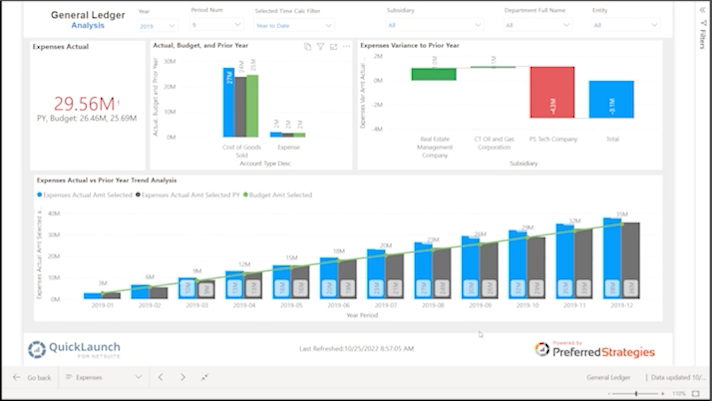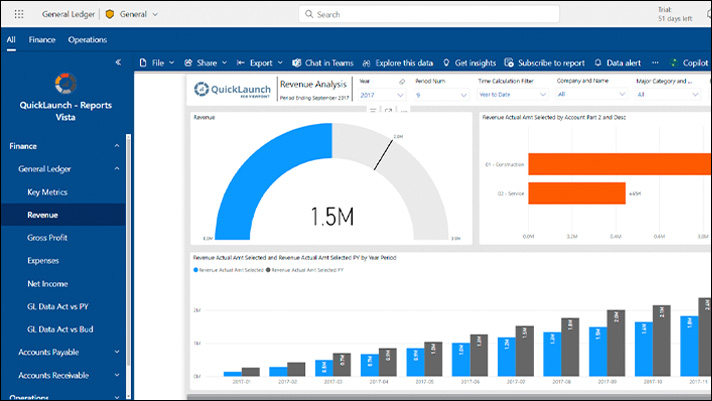- Do your teams spend the first hour of every strategic meeting debating whose numbers are correct?
- Is "I'll have to get back to you on that" the most common answer when leaders ask for a specific data point?
- Do your analysts spend more time exporting data to spreadsheets and manually reconciling reports than they do on actual analysis?
- Have you ever launched a product or initiative based on one department's data, only to be blindsided by its unforeseen impact on another department?
- Does your IT department manage multiple, overlapping BI and reporting tools for different teams?
- Have promising AI or machine learning initiatives stalled because the data was too difficult to access, clean, and connect?
A Deeper Dive into the 5 Hidden Data Fragmentation Costs
1. The Tax on Productivity and Labor At its most basic level, the data silo tax is a direct drain on your payroll. Consider the daily reality for a skilled financial analyst or operations manager in a fragmented data environment. Their day begins not with strategic analysis, but with a series of manual, low-value tasks. They have to log into multiple systems, export raw data to spreadsheets, and then manually attempt to stitch it all together, hoping the date formats and customer names line up. This isn't just inefficient; it's a profound waste of your most valuable talent. Instead of leveraging their expertise to uncover insights and drive growth, they are forced to act as human data integrators. A study by Anaconda found that data scientists spend a staggering 45% of their time on data preparation and cleaning alone.1 This "data janitor" work is a direct productivity tax, leading to employee burnout, error-prone analysis, delayed projects, and a significant inflation of your operational costs.2. The Tax on Decision-Making and Opportunity
The most damaging cost of the data silo tax is often the one that never appears on a balance sheet: the cost of a bad decision. When a CFO cannot get a real-time, consolidated view of cash flow across all business units, they may make a conservative capital allocation decision that causes them to miss a critical growth opportunity. When a COO lacks end-to-end supply chain visibility, they cannot proactively respond to a disruption in one region before it cascades into a massive, customer-impacting problem in another. In a siloed environment, leaders are forced to make decisions with incomplete, outdated, or contradictory information. This creates a culture of hesitation, where gut feel and anecdote have to fill the gaps left by unreliable data. The true cost isn't just the bad decisions you make; it's the game-changing, proactive decisions you never have the confidence to even consider.3. The Tax on Trust
When the sales team’s report on quarterly bookings and the finance team’s report on recognized revenue tell two completely different stories, a toxic data credibility crisis is born. Business users quickly learn to mistrust the numbers. Every dashboard is viewed with skepticism, and every new report is met with a barrage of questions about the data’s origin and accuracy. This erodes the very foundation of a data-driven culture. It undermines investments in analytics tools and training, as users revert to their own departmental spreadsheets because they are the only numbers they feel they can control. The tax on trust is a corrosive force that makes it nearly impossible to align the organization around common goals and objective facts, ensuring that strategic conversations remain mired in opinion rather than evidence.4. The Tax on IT and Technology
For the IT department, data silos create a complex, inefficient, and expensive nightmare. To support each departmental island, IT is forced to purchase, implement, and maintain a patchwork of redundant and overlapping BI and reporting tools. The finance team has their preferred system, marketing uses another, and operations has a third. This bloated and fragmented tech stack is a massive drain on the IT budget and a source of significant technical debt. IT staff spend their time on low-value maintenance and integration "band-aids" instead of focusing on high-impact innovation. Furthermore, this brittle environment is a security risk, with inconsistent access controls and data governance policies across dozens of systems creating a wide and vulnerable threat surface.5. The Tax on Innovation
Perhaps most critically, a fragmented data foundation makes it impossible to compete in the modern era of analytics. You simply cannot build the future of your business on a broken foundation. Advanced capabilities like Artificial Intelligence (AI) and Machine Learning (ML) are not magic; they are powerful tools that require vast amounts of clean, connected, high-quality data to function. Without a unified data source, your AI initiatives will be limited to narrow, experimental use cases with little potential for transformative impact. Meanwhile, your competitors who have solved their data fragmentation problems are already leveraging AI to create significant competitive advantages. The tax on innovation is the gap between where your business is and where it needs to be to survive and thrive in the coming years.How to Quantify the Tax in Your Organization
The Data Silo Tax is more than a concept; it's a real number impacting your bottom line. To begin quantifying it, leaders should ask their teams the following questions. The answers will help you build a business case for change by revealing the true cost of fragmentation.- Audit Your Technology Spend: How much are we spending on redundant, overlapping BI and reporting tools across different departments? What is the annual cost of the licenses, subscriptions, and maintenance for all of them combined?
- Track Your Team's "Wasted" Time: How many hours do our skilled analysts and managers waste each week manually finding, cleaning, and reconciling data instead of performing high-value analysis? (Multiply these hours by a loaded hourly rate to get a direct labor cost).
- Measure Your "Time-to-Decision": How long does it take, on average, to get a trusted answer to a critical, cross-functional business question? What is the business cost of that delay?
- Evaluate Your Strategic Agility: Can we identify specific market opportunities we missed or were slow to react to because of a lack of accessible, comprehensive data?
Case in Point: How Unified Data Generated an $8M Annual Return
The costs of the Data Silo Tax are real, but so are the returns from eliminating it. Consider the case of The International Group (IGI), a leader in the wax industry. The Challenge: IGI's primary challenge was a lack of a centralized location for their enterprise data. Their critical ERP and manufacturing systems operated in separate silos, making a single, comprehensive view of their operations impossible. This fragmentation meant that true, cross-functional business intelligence was out of reach, and any forward-looking AI or machine learning initiatives were non-starters. Without a solid, unified data foundation, they couldn't leverage their data as a strategic asset. The Solution: IGI implemented a unified analytics platform, connecting their ERP and manufacturing systems into a single source of truth. This gave their engineers and operators immediate, self-service access to the data they needed to analyze results and advise on process changes in the moment. The Results: The transformation was staggering.- A Foundation for Innovation: With clean, connected data, IGI was able to apply machine learning and AI to their manufacturing process.
- Massive Financial Impact: By analyzing this unified data, the AI models were able to identify optimal settings that reduced manufacturing waste from 8% to 4%, directly increasing profit by $8-10 million per year.
The Path Forward: A Glimpse into the Blueprint for Success
Escaping the Data Silo Tax requires a deliberate shift from fragmented reporting to a unified Enterprise Intelligence strategy. This journey, which turned IGI's data into a multi-million dollar asset, follows a proven, three-step framework.- Connect: The journey begins by creating automated data pipelines to reliably replicate information from all your disparate data sources. This replaces manual data extraction and ensures a consistent, timely flow of information from your core enterprise systems.
- Centralize: Next, you must consolidate this data into a modern, AI-ready data foundation, like a data Lakehouse. This provides a single, scalable, and governed home for all your enterprise data, creating the prerequisite for both trustworthy BI, AI, and advanced analytics.
- Conquer: Finally, you must transform the centralized data into actionable intelligence with an enterprise-grade semantic model. This is the crucial translation layer that applies business logic and makes the data accessible, understandable, and useful for every business user, from the shop floor to the C-suite.
Your Detailed Blueprint for a Unified Future
This framework provides a clear path to eliminating data silos and reclaiming the costs of a disconnected business. To help you execute this plan, we've created a comprehensive, step-by-step guide. Ready to Stop Paying the Data Silo Tax? Download our free ebook, "Connect. Centralize. Conquer. Your Blueprint for Achieving Enterprise-Wide Intelligence," and get the actionable plan you need to build a unified data foundation and drive your business into the future. [DOWNLOAD YOUR BLUEPRINT NOW] References: [post_title] => The Data Silo Tax: Calculating the Hidden Costs of Data Silos [post_excerpt] => [post_status] => publish [comment_status] => open [ping_status] => open [post_password] => [post_name] => costs-of-data-silos [to_ping] => [pinged] => [post_modified] => 2025-08-12 15:23:37 [post_modified_gmt] => 2025-08-12 22:23:37 [post_content_filtered] => [post_parent] => 0 [guid] => https://quicklaunchanalytics.com/?p=12588 [menu_order] => 0 [post_type] => post [post_mime_type] => [comment_count] => 0 [filter] => raw ) [1] => WP_Post Object ( [ID] => 12585 [post_author] => 6 [post_date] => 2025-08-01 14:32:57 [post_date_gmt] => 2025-08-01 21:32:57 [post_content] => Picture this: It's Monday morning, and you're walking into a critical board meeting armed with what you believe are your company's most important performance metrics. Five minutes into your presentation, your CFO interrupts with a completely different set of numbers for the same KPIs. Your VP of Sales chimes in with yet another figure. Suddenly, instead of discussing strategy, you're debating which system has the "real" data. This is the frustrating reality in most organizations. You're not suffering from a lack of data; you're suffering from a lack of enterprise BI integration. When business intelligence systems and the data that feeds them operate in disconnected silos, they create confusion, erode trust, and prevent you from seeing the holistic picture of your business. This fragmentation isn't just an inconvenience; it's a significant drag on performance. In fact, studies show that knowledge workers can spend nearly 20% of their work week—the equivalent of one full day—simply searching for and organizing the information they need to do their jobs effectively. True enterprise intelligence isn't about having more dashboards; it's about having a single, unified view through effective business intelligence consolidation. Achieving this requires a deliberate enterprise BI integration strategy. This guide provides a proven, three-step framework to move from a state of BI chaos to one of cohesive, enterprise-wide clarity.Why Enterprise BI Integration is Critical: The High Cost of BI Chaos
Before diving into the solution, it's crucial to understand the tangible costs of inaction. Operating with disconnected BI systems imposes a hidden Data Silo Tax on your business that shows up in five key areas.- The Productivity Drain: The most immediate cost is wasted time. Your skilled (and expensive) analysts and managers are forced to spend hours manually exporting data from multiple systems into spreadsheets, attempting to reconcile conflicting numbers, and piecing together reports. This low-value "data janitor" work is a direct drain on payroll and a primary cause of burnout for your best talent.
- Strategic Decision Paralysis: The cost of bad data can be staggering, with Gartner estimating that poor data quality costs organizations an average of $12.9 million every year. When leaders are presented with conflicting reports from sales and finance, meetings devolve into debates about whose numbers are right, rather than decisive strategic conversations. This lack of data confidence leads to hesitation, indecision, and a dangerous reliance on "gut feel" to make critical business choices.
- Eroded Trust: A constant stream of inconsistent data creates a toxic culture of mistrust. Business users learn to doubt the analytics provided by IT and revert to their own departmental "shadow IT" systems—usually spreadsheets—because they are the only numbers they feel they can control. This undermines the entire investment in a data-driven culture and makes organizational alignment impossible.
- Technology Bloat: IT departments find themselves managing an expensive patchwork of overlapping BI tools, each with its own licensing costs, security requirements, and maintenance overhead. This tech debt grows exponentially, consuming budget that could be invested in innovation.
- The Innovation Roadblock: Perhaps most critically, disconnected BI systems make advanced analytics initiatives nearly impossible. AI and machine learning projects require clean, connected, comprehensive data, something that's virtually impossible to achieve in a fragmented environment without proper enterprise BI integration.
Enterprise BI Integration Framework: Connect, Centralize, Conquer
Escaping the high costs of BI chaos requires more than just new technology; it demands a new, strategic approach to BI system integration. A successful strategy must address three critical layers of the business: the foundational data pipelines that connect to your systems, the central platform where data is unified, and the business-facing analytics layer where insights are generated. This proven enterprise BI integration methodology is called the Connect, Centralize, Conquer framework. It is a three-step blueprint designed to transform a fragmented data landscape into a cohesive engine for enterprise intelligence.- CONNECT: First, you establish a resilient and automated data pipeline layer to reliably extract information from all your disparate source systems.
- CENTRALIZE: Next, you create a single source of truth by consolidating that information into a modern, governed, and scalable data integration platform.
- CONQUER: Finally, you unlock the full value of your data by creating a universal semantic model that makes complex information accessible and consistent for all business users and BI tools.
Step 1: CONNECT - Create a Resilient Data Pipeline Layer
The foundation of any successful enterprise BI integration is the ability to reliably and efficiently connect to your various data sources. This means moving beyond the brittle, high-maintenance integration methods of the past.The Limits of Traditional ETL
For years, the standard was custom-coded, point-to-point ETL (Extract, Transform, Load) processes. While functional for simpler environments, this approach fails in the modern enterprise. These custom connections are rigid; when a source system (like your ERP) is updated, the connection breaks, requiring costly IT intervention. This creates a constant cycle of maintenance and firefighting, and it simply cannot scale to accommodate the dozens or hundreds of systems in a typical organization.The Modern Integration Layer
A modern enterprise BI integration strategy focuses on building an automated and resilient data pipeline layer. Prioritize Automation Over Manual Extraction: Your first goal should be to eliminate manual data workflows. Instead of analysts exporting spreadsheets, your pipelines should automatically extract data from your core systems on a reliable schedule. Use the Right Tool for the Source: A modern business intelligence consolidation strategy uses a combination of specialized tools.- For SQL Databases: Use a direct replication tool that is optimized for high-performance data synchronization from on-premise or cloud databases.
- For Cloud Applications: Leverage an ELT service that offers a library of pre-built API connectors for your SaaS platforms (e.g., Salesforce, NetSuite), ensuring connectivity is maintained even when those applications are updated.
Step 2: CENTRALIZE - Build a Unified Data Integration Platform
Once your data is flowing reliably through your enterprise BI integration pipelines, it needs a single, central home. Attempting to connect BI tools directly to a multitude of operational systems is a recipe for disaster. The modern, strategic approach is to centralize your data in a data lakehouse. This architecture combines the flexibility of a data lake with the governance and performance of a traditional data warehouse, creating the ideal foundation for all enterprise analytics integration. It serves as a stable, scalable, and governed platform that sits between your complex source systems and your BI tools. Within the lakehouse, a medallion architecture is used to progressively refine the data, ensuring quality and usability:- Bronze Zone: Raw, untouched data is ingested from the source systems, creating a complete historical archive for auditing and reprocessing.
- Silver Zone: The data is cleaned, standardized, and conformed. This is where data from different systems is reconciled to create a consistent and reliable source of truth.
- Gold Zone: Business-ready, aggregated datasets are created. These are optimized for high-performance analytics and reporting, making it easy for BI tools to access the data.
Step 3: CONQUER - Unify with Enterprise Data Models
The final and most critical step is to conquer the analysis gap. Even with clean, centralized data, you need a way to make it accessible and understandable to the business. This is the role of the enterprise semantic model in your enterprise BI integration strategy. Think of the semantic model as a universal translator or a "business map" of your data. It is a logical layer that sits on top of your data lakehouse and serves all your BI tools. It's the key to turning a technical asset (the lakehouse) into a business-friendly resource.- It Standardizes Business Logic: The semantic model is where your key business metrics are given a single, universal definition. Calculations for "Gross Profit" or "Customer Lifetime Value" are embedded in the model once, ensuring every report and every dashboard across the entire organization is using the exact same logic.
- It Organizes Data into Logical Business Views: A semantic model takes the hundreds of clean tables available in the data foundation and organizes them into intuitive, subject-specific views called Perspectives. This means all data related to Accounts Payable—vendors, invoices, payments, etc.—is presented together in a clean, curated environment. This structure simplifies complexity and provides a logical map of the data before a user even begins their analysis.
- It Enables True Self-Service: By providing an intuitive and governed view of the data, the semantic model empowers business users to answer their own questions and create their own insights in their BI tool of choice, freeing up your data team to focus on more strategic initiatives.
- It Enables True Cross-Functional Analysis: A semantic model's most powerful feature is its ability to connect and blend data from traditionally separate business functions. For example, it can unify data from sales, inventory, procurement, and manufacturing into a single "Supply and Demand" perspective. This allows leaders to see precisely how a sales forecast will impact production schedules or how a procurement delay might affect future revenue—holistic insights that are impossible to achieve when data is trapped in functional silos.
Common Enterprise BI Integration Challenges and Solutions
Every enterprise BI integration project faces predictable obstacles. Understanding these challenges upfront and planning for them is the single most effective way to ensure your initiative succeeds and delivers on its promise.1. Lack of Executive Sponsorship
- The Challenge: When BI system integration is perceived as a purely "IT" project, it fails to gain the urgency and cross-departmental cooperation needed for success. Without strong sponsorship from business leadership, the initiative can stall due to competing priorities and resistance from departments protective of their data.
- The Solution: The project must be framed and led as a core business strategy, not a technical upgrade. Sponsorship must be visible and vocal from the C-suite, and the project's goals must be explicitly tied to concrete business outcomes, such as improving profitability or accelerating time-to-market, rather than just technical deliverables.
2. Legacy System & Integration Complexity
- The Challenge: Your organization has decades of accumulated technology debt, including legacy systems never designed to share data, proprietary formats that resist standardization, and custom applications with no documented APIs. Attempting to connect everything at once is a recipe for failure.
- The Solution: Adopt a phased enterprise BI integration strategy that prioritizes business value. Start by identifying your most critical data sources and establishing connections to those systems first to deliver an early win. Leverage modern integration platforms that are flexible enough to handle a variety of connection methods, from modern APIs to direct database connections for older systems.
3. Data Quality and Consistency Issues
- The Challenge: When you finally connect all your systems through business intelligence consolidation, you will inevitably discover that what you thought was the same data often isn't. Customer names are formatted differently across your CRM and ERP, product codes are inconsistent, and business rules have evolved independently in each silo.
- The Solution: Do not treat data quality as an afterthought in your enterprise BI integration project. Implement data profiling and automated quality monitoring as part of your data pipeline process from day one. Establish clear data stewardship roles within the business to take ownership of data quality. Crucially, balance the quest for perfection with progress—address the most critical data quality issues first while continuing to move forward.
4. Neglecting Data Governance
- The Challenge: Without a governance framework, a new, unified data integration platform can quickly become just as chaotic and untrustworthy as the silos it replaced. Without clear rules for how metrics are defined, how data is secured, and how quality is maintained, the single source of truth will quickly fracture.
- The Solution: Begin with a flexible governance model focused on your most critical business metrics and data entities. Implement essential security and access controls from the very beginning, but allow the full governance framework to evolve incrementally as the technical capabilities and user base mature.
5. Poor Change Management and User Adoption
- The Challenge: Enterprise BI integration is an organizational transformation that changes established workflows and roles. A perfectly designed technical solution that no one uses provides zero business value. Resistance to change and low user adoption are the primary reasons these projects fail to deliver ROI.
- The Solution: Treat the project as a change management initiative from the very beginning. Involve business users and key stakeholders in the design process to build a sense of ownership. Develop role-specific training and support resources and celebrate early wins to build momentum. Identify and empower analytics champions within business units who can advocate for the new system and support their peers.
Measuring Success: ROI of Enterprise BI Integration
Successful enterprise BI integration initiatives deliver measurable returns across multiple dimensions: Direct Cost Savings:- Reduced technology spend through BI tool consolidation
- Improved analyst productivity (typically 40-60% time savings)
- Faster decision-making cycles
- Enhanced cross-selling opportunities through unified customer views
- Improved operational efficiency through integrated analytics
- Faster market response through real-time insights
- Foundation for AI and machine learning initiatives
- Enhanced regulatory compliance and reporting
- Improved competitive positioning through data-driven insights
Enterprise BI Integration Best Practices
To maximize the success of your enterprise analytics integration initiative:- Start with Business Outcomes: Define clear success metrics before selecting technology
- Adopt Phased Implementation: Build momentum through early wins
- Invest in Data Governance: Establish standards from day one
- Plan for Change Management: Ensure user adoption through training and support
- Design for Scalability: Build architecture that can grow with your needs
Your Next Move: From Fragmentation to a Foundation for the Future
The path forward presents a clear and critical choice. You can continue paying the hidden tax of data fragmentation—wasting resources on reconciling conflicting reports and making strategic decisions with an incomplete picture of your business. Or, you can build a unified foundation that transforms your data from a source of chaos into your most powerful strategic asset through comprehensive enterprise BI integration. The Connect, Centralize, Conquer framework provides the blueprint for this transformation. It's a proven methodology for moving beyond simply managing data to truly commanding it. Following this path not only solves today's most pressing reporting challenges but also builds the resilient, AI-ready platform required to outmaneuver the competition for years to come. This guide has provided the framework for successful enterprise BI integration. The next step is to get the detailed implementation plan. Ready to Build Your Blueprint for Integration? This guide provides the framework, but our comprehensive ebook provides the detailed plan. Download "Connect. Centralize. Conquer: Your Blueprint for Achieving Enterprise-Wide Intelligence" to get the step-by-step guidance you need to create a truly unified enterprise analytics integration platform. [DOWNLOAD THE EBOOK NOW]Frequently Asked Questions About Enterprise BI Integration
Q: How long does enterprise BI integration typically take? A: Most enterprise BI integration projects show initial value within 3-6 months, with full implementation typically completed within 12-18 months. The timeline depends on the complexity of your data landscape and the scope of integration. Q: What's the difference between BI integration and data integration? A: BI system integration focuses specifically on connecting business intelligence tools and creating unified analytics, while data integration is broader and includes all data movement and consolidation activities across the enterprise. Q: Do we need to replace all our existing BI tools for successful integration? A: Not necessarily. Effective business intelligence consolidation can often work with existing tools by creating a unified data layer. However, you may find that tool consolidation reduces complexity and costs over time. Q: What are the biggest risks in enterprise BI integration projects? A: The primary risks include treating it as a purely technical project rather than a business transformation, inadequate change management, poor data governance, and attempting to integrate everything simultaneously rather than taking a phased approach. Q: How do we handle data security in an integrated environment? A: Enterprise BI integration actually enhances security by enabling centralized governance, consistent access controls, and comprehensive audit trails. However, it requires careful planning to ensure sensitive data protection throughout the integration process. Q: What skills are needed for successful BI integration? A: Successful enterprise BI integration requires a combination of technical skills (data engineering, integration platforms), business skills (process analysis, domain expertise), and project management capabilities. Many organizations partner with experienced consultants for specialized expertise. Q: How do we ensure data quality in integrated systems? A: Implement automated data profiling, quality monitoring, and cleansing processes as part of your data integration platform. Establish clear data stewardship roles and address critical quality issues systematically rather than trying to achieve perfection immediately. Q: What's the ROI timeline for enterprise BI integration? A: Organizations typically see initial productivity gains within 3-6 months, with more significant strategic benefits emerging over 12-24 months as advanced analytics capabilities are implemented and user adoption increases. [post_title] => The Definitive Guide to Enterprise BI Integration: From Strategy to Execution [post_excerpt] => [post_status] => publish [comment_status] => open [ping_status] => open [post_password] => [post_name] => guide-enterprise-bi-integration [to_ping] => [pinged] => [post_modified] => 2025-08-12 15:13:51 [post_modified_gmt] => 2025-08-12 22:13:51 [post_content_filtered] => [post_parent] => 0 [guid] => https://quicklaunchanalytics.com/?p=12585 [menu_order] => 0 [post_type] => post [post_mime_type] => [comment_count] => 0 [filter] => raw ) [2] => WP_Post Object ( [ID] => 12555 [post_author] => 22 [post_date] => 2025-08-01 08:24:27 [post_date_gmt] => 2025-08-01 15:24:27 [post_content] => [post_title] => CCC EBook [post_excerpt] => [post_status] => publish [comment_status] => closed [ping_status] => closed [post_password] => [post_name] => ccc-ebook [to_ping] => [pinged] => [post_modified] => 2025-08-04 14:48:25 [post_modified_gmt] => 2025-08-04 21:48:25 [post_content_filtered] => [post_parent] => 0 [guid] => https://quicklaunchanalytics.com/?post_type=resource&p=12555 [menu_order] => 0 [post_type] => resource [post_mime_type] => [comment_count] => 0 [filter] => raw ) [3] => WP_Post Object ( [ID] => 11789 [post_author] => 6 [post_date] => 2025-05-30 13:56:07 [post_date_gmt] => 2025-05-30 20:56:07 [post_content] => In the high-stakes world of enterprise analytics, choosing the wrong data platform can cost your organization millions in wasted resources and missed opportunities. As data volumes explode and AI transforms business operations, organizations face a critical question: build your analytics foundation on mature, data science-centric Databricks technology, or embrace Microsoft's new integrated, user-friendly Fabric ecosystem? At QuickLaunch Analytics, we've worked extensively with both and witnessed firsthand what works, what doesn't, and which platform is ready for enterprise-grade analytics. This comprehensive comparison will help you understand which company might better align with your enterprise data strategy in today's rapidly evolving tech landscape.The Lakehouse Foundation
Both Databricks and Microsoft Fabric employ a "Lakehouse" architecture, which represents the evolution of traditional data warehouses and data lakes. This hybrid approach combines the flexibility and scalability of data lakes with the structured query capabilities and performance optimizations of data warehouses. A robust Lakehouse foundation provides essential capabilities for cloud-based data movement, storage, and transformation into analytics-ready structures while supporting diverse workloads from business intelligence to advanced machine learning.Databricks: The Mature Pioneer in Data Science and Engineering
Databricks was founded in 2013 by the original creators of Apache Spark at UC Berkeley's AMPLab. It was built as a cloud-based data and AI platform designed to unify data engineering, data science, machine learning, and analytics. The company has since grown into a leader in the Lakehouse architecture movement, combining data lakes and data warehouses for enterprise-scale analytics. Technical Architecture and Capabilities Databricks' technical core is built around Delta Lake, an open-source storage layer that brings reliability to data lakes. Delta Lake provides ACID transactions, scalable metadata handling, and unifies streaming and batch data processing. This foundation enables Databricks to excel in several key areas:- Unified Data Processing: The Databricks Lakehouse Platform combines data warehousing and AI capabilities in a single system, eliminating the need to maintain separate systems for different data workloads.
- Delta Engine: A high-performance query engine optimized for Delta Lake that significantly accelerates data processing workloads.
- MLflow Integration: Built-in machine learning lifecycle management, from experimentation to production deployment.
- Photon Engine: A vectorized query engine that enhances SQL performance for data analytics workloads.
- Requires more robust data engineering skills
- Involves more infrastructure management
- BI and reporting capabilities aren't native (requires integration with tools like Power BI)
Fabric: The Integrated Newcomer with Microsoft DNA
Microsoft Fabric was officially announced in May 2023, representing an integration of previously standalone products including Azure Synapse, Azure Data Factory, Power BI, and Azure Data Lake Storage into a comprehensive SaaS offering. The platform continues Microsoft's strategy of creating tightly integrated ecosystems that prioritize ease of use and interoperability within the Microsoft technology stack. Technical Architecture and Components Microsoft Fabric's architecture centers around OneLake, a unified storage layer that serves as the foundation for all Fabric experiences. The platform includes several integrated components:- Data Factory: Data integration service for orchestrating and automating data movement
- Data Engineering: Apache Spark-based environment for data transformation and preparation
- Data Warehouse: SQL-based analytics engine optimized for complex queries on structured data
- Real-time Analytics: Stream processing capabilities for analyzing data in motion
- Power BI: Industry-leading business intelligence and visualization capabilities
- Data Science: Machine learning and AI tools for predictive analytics
- Data Activator: Event-based automation to trigger actions based on data patterns
- Near real-time analytics on fresh data
- Analysis of larger datasets without memory constraints
- Reduced data duplication and management overhead
- As of May 2025, Fabric remains less mature due to its assembly of several separate products
- Product fragmentation exists between the Lakehouse side using Spark and the Data Warehouse side using Synapse
- Less robust for heavy data science and advanced ML workloads
- More "Microsoft-only" ecosystem constraints
- Fixed capacity pricing model where you must determine minimum resources for all jobs and tasks in advance
Our Current Recommendation
As of May 2025, our recommendation is to use Databricks as the Lakehouse solution for most enterprise use cases. Databricks leads in data movement, storage, and transformation capabilities. Its usage-based pricing model typically proves more cost-effective for most QuickLaunch customers compared to Fabric's capacity-based pricing. Additionally, Databricks includes industry-leading data science capabilities for AI/ML applications. That said, Power BI remains the industry leader for data visualization regardless of your Lakehouse platform choice. Despite Power BI being part of the Fabric ecosystem, it works seamlessly with Databricks. And while Power BI's integration with other Fabric tools may eventually make the full Fabric ecosystem more compelling, in our current assessment, that time hasn't yet arrived.Making the Right Choice for Your Organization
When selecting between Databricks and Microsoft Fabric, consider these factors:- Technical Expertise: Does your team have strong data engineering skills (favoring Databricks) or are they more comfortable in the Microsoft ecosystem (favoring Fabric)?
- Data Science Requirements: If advanced analytics and machine learning are priorities, Databricks offers more mature capabilities with tighter integration of MLflow and better support for complex algorithms and model deployment.
- Cost Structure Alignment: Evaluate whether your workload patterns align better with Databricks' pay-for-what-you-use model or Fabric's capacity-based pricing. Variable workloads typically benefit from Databricks' approach, while consistent usage patterns might be more cost-effective with Fabric.
- Cloud Strategy: Is multi-cloud flexibility important, or are you committed to Microsoft Azure? Databricks offers true multi-cloud deployment options, while Fabric is Azure-centric.
- Scale of Implementation: For very large-scale implementations processing petabytes of data, Databricks has a longer track record of success at extreme scale.
The QuickLaunch Advantage
Regardless of which platform you choose, QuickLaunch Analytics provides solutions that accelerate your enterprise analytics journey. Our Foundation Pack and Application Packs allow you to leverage pre-built components that dramatically reduce implementation time and cost while ensuring best practices. We'll continue monitoring both platforms' evolution and update our recommendations as capabilities advance. The ideal solution depends on your organization's specific needs, existing infrastructure, and strategic goals—and we're here to help you navigate that decision. Would you like to learn more about how QuickLaunch Analytics can help you implement enterprise analytics on either Databricks or Microsoft Fabric? Contact our team for a personalized consultation. Feature Comparison Here is a summary of the differences between Databricks and Fabric.| Feature/Aspect | Databricks | Microsoft Fabric |
| Core Purpose | Data Engineering, Data Science & AI Platform (Lakehouse) | End-to-End SaaS Data Platform (BI, Data Engineering, Warehousing, Real-time, AI) |
| Vendor | Databricks (partnered heavily with Azure, AWS, GCP) | Microsoft (deeply integrated with Azure & Power BI) |
| Architecture | Lakehouse architecture (Delta Lake) | All-in-one SaaS platform (lake-centric but broad) |
| Data Storage | Delta Lake on cloud storage (S3, ADLS, GCS) | OneLake (unified storage layer) |
| Language Support | Spark (Python, Scala, SQL, R), MLflow, notebooks | SQL-first, but also supports Python, notebooks, DAX |
| Strengths | - Big data processing at scale - Machine Learning & AI native - Open & Multi-cloud - Flexible & highly performant for complex data workflows | - Tight Power BI integration - End-to-End governance & security in Microsoft ecosystem - Lower learning curve for SQL/BI users - SaaS simplicity (no infrastructure) |
| Weaknesses | - Requires more data engineering skills - More infrastructure management - BI & reporting is not native (requires Power BI or Looker) | - Less mature for heavy data science / advanced ML workloads - More "Microsoft-only" ecosystem - Newer platform, some features evolving |
| Pricing | Pay for what you use, each job or task can be scaled to be as cost or performant as needed. | You must determine the minimum resources for all jobs and tasks to pick which base capacity and pricing for all jobs/tasks. |
| Target Users | Data Engineers, Data Scientists, ML Engineers | Business Analysts, Data Engineers, BI teams, Business users |
| Integration | Multi-cloud, open source friendly | Deeply embedded in Microsoft ecosystem (Azure, Power BI, Teams, Excel) |
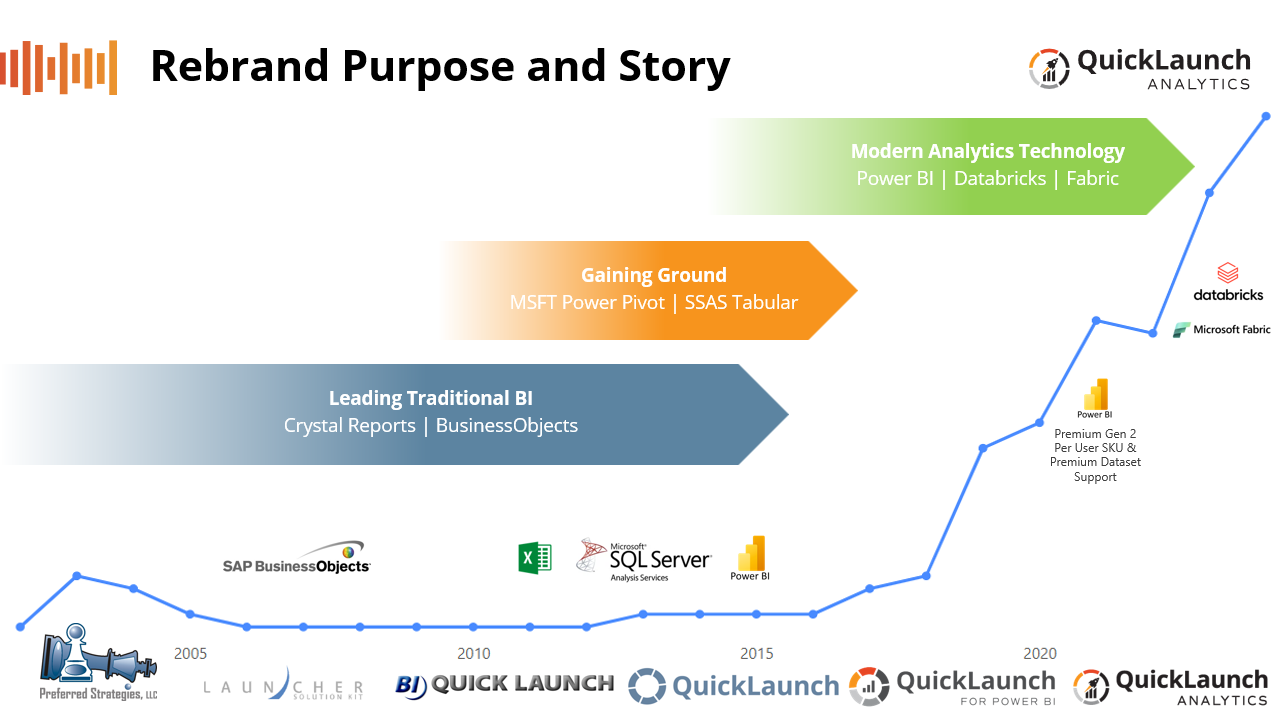 A Legacy of Innovation
Our history is one of constant innovation and adaptation. From the early days of helping businesses generate reporting insights with Crystal Reports, to embracing technologies like BusinessObjects and later pivoting into the Microsoft BI ecosystem, we’ve always prioritized staying ahead of the curve.
In 2015, as Power BI emerged, we were already paving the way with robust Power Pivot and Tabular models that complemented our SQL Data Warehouse solution, cementing our reputation as leaders in ERP-specific data analysis. QuickLaunch Analytics builds on this tradition, while setting the stage for new products that will focus on integrating all your organization’s data sources into seamless, cloud-first solutions that empower organizations to unlock the full potential of their data.
What This Means for Our Customers
While our name is changing, our commitment to our customers remains steadfast. You’ll see updates to our branding across our website, social media channels, and communications in the coming months, but the same dedicated team, high-quality solutions, and unparalleled support you’ve come to expect will remain unchanged.
By rebranding to QuickLaunch Analytics, we aim to strengthen our identity as an analytics company and make it easier for existing and potential customers to understand what we do and why we’re the right choice for their needs.
Elements of the New Look
You may notice a nod to the old logo, with a sleeker donut chart, reimagined column chart with a rocket ship, and similar colors as Preferred Strategies with the addition of black as the primary font color. This was intentional so that there was recognition between the two but also because we love data visualization and wanted to keep as many elements of this as possible.
The rocket ship is obviously a play on the QuickLaunch theme and meant to represent the exploration of new data frontiers as well as signifying the growth that is promised from such an endeavor. We are excited to have these new creative legs to stand on and have some cool related brand elements that we will be releasing in upcoming campaigns that will represent this further.
A Legacy of Innovation
Our history is one of constant innovation and adaptation. From the early days of helping businesses generate reporting insights with Crystal Reports, to embracing technologies like BusinessObjects and later pivoting into the Microsoft BI ecosystem, we’ve always prioritized staying ahead of the curve.
In 2015, as Power BI emerged, we were already paving the way with robust Power Pivot and Tabular models that complemented our SQL Data Warehouse solution, cementing our reputation as leaders in ERP-specific data analysis. QuickLaunch Analytics builds on this tradition, while setting the stage for new products that will focus on integrating all your organization’s data sources into seamless, cloud-first solutions that empower organizations to unlock the full potential of their data.
What This Means for Our Customers
While our name is changing, our commitment to our customers remains steadfast. You’ll see updates to our branding across our website, social media channels, and communications in the coming months, but the same dedicated team, high-quality solutions, and unparalleled support you’ve come to expect will remain unchanged.
By rebranding to QuickLaunch Analytics, we aim to strengthen our identity as an analytics company and make it easier for existing and potential customers to understand what we do and why we’re the right choice for their needs.
Elements of the New Look
You may notice a nod to the old logo, with a sleeker donut chart, reimagined column chart with a rocket ship, and similar colors as Preferred Strategies with the addition of black as the primary font color. This was intentional so that there was recognition between the two but also because we love data visualization and wanted to keep as many elements of this as possible.
The rocket ship is obviously a play on the QuickLaunch theme and meant to represent the exploration of new data frontiers as well as signifying the growth that is promised from such an endeavor. We are excited to have these new creative legs to stand on and have some cool related brand elements that we will be releasing in upcoming campaigns that will represent this further.
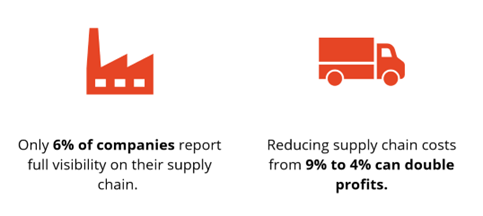 At QuickLaunch Analytics, we’ve been helping manufacturing companies that run JD Edwards gain visibility into their supply chain processes since 2002 with our QuickLaunch for JDE solution. The latest QuickLaunch product release includes an innovative way for companies to improve inventory management by anticipating inventory shortages and making corrective actions before their supply chain is impacted further.
Watch the latest education session our CEO, Todd Wilson recently presented about JDE Supply and Demand Planning and his experiences as CIO of Clif Bar as they worked to optimize their Supply Chain process.
The QuickLaunch Supply & Demand Planning solution offers Material Planners a comprehensive tool to review inventory items and drill into details about inventory supply and demand sources, all within a single Power BI dashboard. The solution integrates JD Edwards Supply Chain data from the Inventory, Purchasing, Sales, Work Order Header, Work Order Parts List, and Work Order Router transaction tables and presents it back to business users in an easy-to-comprehend Power BI data model.
At QuickLaunch Analytics, we’ve been helping manufacturing companies that run JD Edwards gain visibility into their supply chain processes since 2002 with our QuickLaunch for JDE solution. The latest QuickLaunch product release includes an innovative way for companies to improve inventory management by anticipating inventory shortages and making corrective actions before their supply chain is impacted further.
Watch the latest education session our CEO, Todd Wilson recently presented about JDE Supply and Demand Planning and his experiences as CIO of Clif Bar as they worked to optimize their Supply Chain process.
The QuickLaunch Supply & Demand Planning solution offers Material Planners a comprehensive tool to review inventory items and drill into details about inventory supply and demand sources, all within a single Power BI dashboard. The solution integrates JD Edwards Supply Chain data from the Inventory, Purchasing, Sales, Work Order Header, Work Order Parts List, and Work Order Router transaction tables and presents it back to business users in an easy-to-comprehend Power BI data model.
 Challenges with Native JDE Supply and Demand Reporting
The current release of JD Edwards only supports viewing one item at a time through the Supply & Demand Inquiry Application. In addition, users can only analyze one Branch/Plant at a time. This can make exception reporting very difficult as users will need to enter every product they manage for each branch, one by one, to try to spot any availability issues. Furthermore, additional JDE applications are needed to explore the supporting detailed data and what might be contributing to problems. This limitation makes identifying potential supply issues both difficult and time-consuming for business users to research and resolve.
Challenges with Native JDE Supply and Demand Reporting
The current release of JD Edwards only supports viewing one item at a time through the Supply & Demand Inquiry Application. In addition, users can only analyze one Branch/Plant at a time. This can make exception reporting very difficult as users will need to enter every product they manage for each branch, one by one, to try to spot any availability issues. Furthermore, additional JDE applications are needed to explore the supporting detailed data and what might be contributing to problems. This limitation makes identifying potential supply issues both difficult and time-consuming for business users to research and resolve.
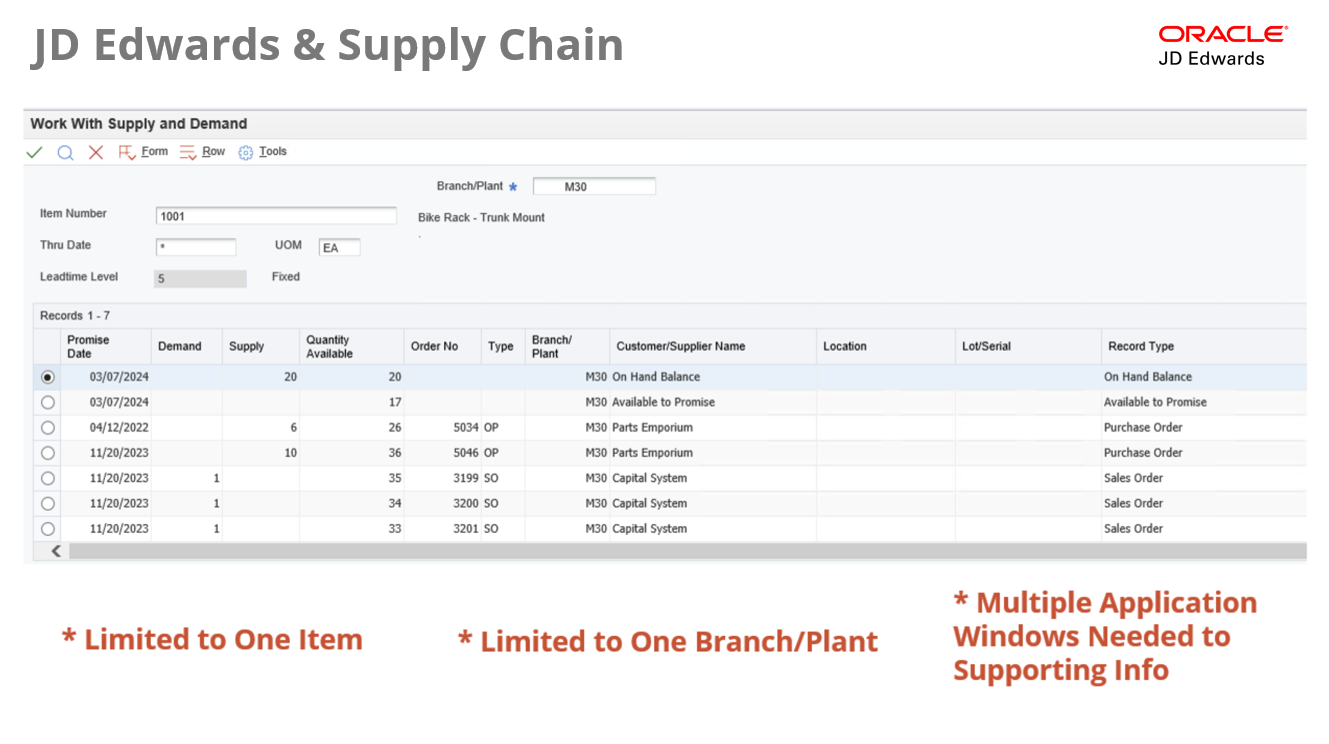 Achieve Better Inventory Management with QuickLaunch
The QuickLaunch Supply & Demand Planning perspective empowers users to investigate inventory items with projected shortages inside an interactive Power BI dashboard pulling in the latest JDE data. With this solution, users can quickly refine the analysis by performing the following:
Achieve Better Inventory Management with QuickLaunch
The QuickLaunch Supply & Demand Planning perspective empowers users to investigate inventory items with projected shortages inside an interactive Power BI dashboard pulling in the latest JDE data. With this solution, users can quickly refine the analysis by performing the following:
- Defining the time range to review items with shortages
- Deciding between stocking types like finished goods or raw material items
- Choosing relevant Branch Plants
- Selecting inventory sources to focus on, such as On Hand, Safety Stock, In Inspection, In Transit, Sales Order, Work Order, WO Parts List, Forecast, Work in Progress.
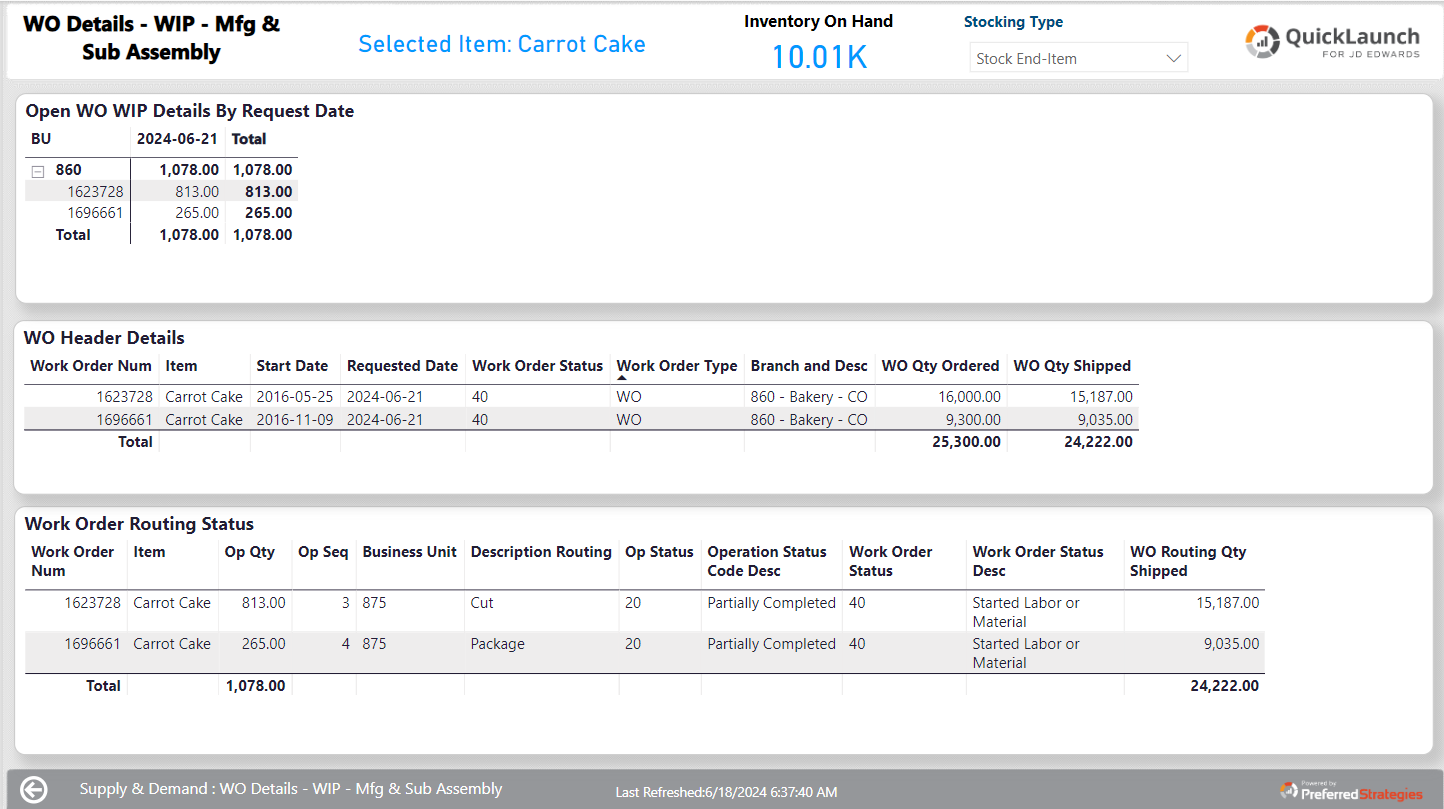 Here’s example of the insights and actions our customers are gaining from this Supply and Demand Planning analysis:
Here’s example of the insights and actions our customers are gaining from this Supply and Demand Planning analysis:
- Identifying where and when shortages for an item will occur
- Determining what is driving the shortage
- Establishing when availability will be restored
- Analyze Work Order details for shortages and contact manufacturing departments to highlight anticipated problem and possible resolutions
- Identify and prioritize what products should have work orders submitted the soonest.
- Drill into Procurement details to identify what products the procurement team should prioritize ordering
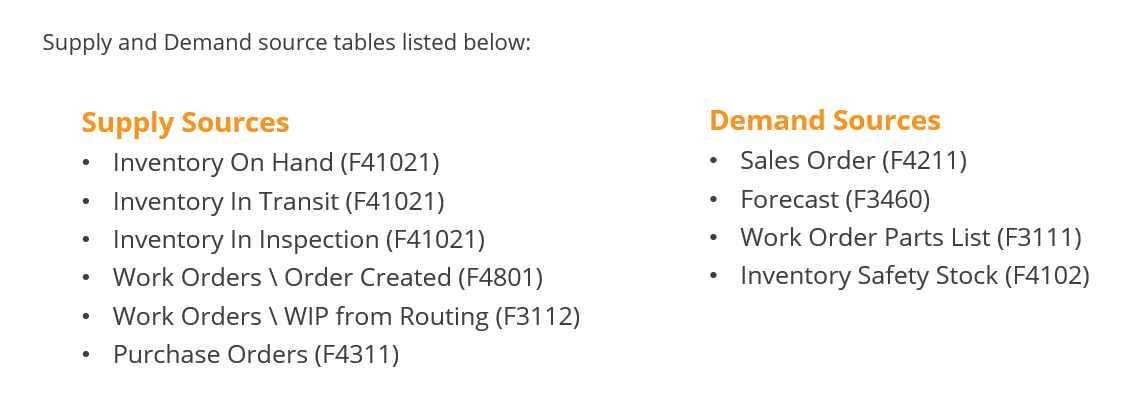 The Supply and Demand module can be customized to suit your company’s specific needs by giving you the flexibility to configure the core components of the solution. For example, you can set up whether Work Orders will be considered as a supply source before or after the order is released to the floor. Here’s a list of different elements that you can customize:
The Supply and Demand module can be customized to suit your company’s specific needs by giving you the flexibility to configure the core components of the solution. For example, you can set up whether Work Orders will be considered as a supply source before or after the order is released to the floor. Here’s a list of different elements that you can customize:
- Quantity – what quantity column from the ERP to use in calculations?
- Unit of Measure Conversions – what UOM do you use for your quantities?
- Projected Date - what date column from the ERP to use in calculations?
- Inclusion Rules – what transactions should be included from each of the source tables?
Optimize Payroll Processes with the New Payroll Detail Prospective
In the Viewpoint Vista ERP application, payroll transactions can be initiated in multiple sub-systems such as Job Cost, Equipment Maintenance, and Service Management. All those feed transactions to a payroll table in order to calculate deductions (like taxes) and liabilities (like vacation) in order to determine gross and net pay. The new payroll detail perspective in QuickLaunch provides a way to analyze company payroll data including straight time, overtime, gross pay, deductions, liabilities, and net pay. This allows aggregated and detailed analysis by a multitude of dimensions including employee, craft, class, pay type, department, job, equipment, service center, etc. This type of payroll analysis can help you with the identification of potentially missing payroll transactions (avoiding the expense of issuing a manual check) and duplicate payroll records (in the event a timecard was inadvertently entered twice). Research into payroll irregularities is much faster with a comprehensive enterprise data platform.Streamline Work Order Management with Equipment Work Orders and Preventative Maintenance
Until now, the QuickLaunch for Vista equipment perspective only included work order costs and hours for completed work. Our new Equipment Work Order and Preventative Maintenance perspective provides comprehensive insight into all work orders including future work orders (scheduled maintenance), current work orders (including those not started or assigned) and completed work orders. Work order activity can be analyzed by counts, backlog, assignments, department, category, component technician, item, etc. to balance workload and maximize productivity. This will enable you to compare estimated versus actual costs and hours to improve performance. Also, using extensive time-based measures, equipment managers will be able identify trends and outliers to manage and schedule assignments more effectively.Extend Asset Life with Equipment Warranty Enhancements
Out-of-the-box, Vista is good at identifying individual warranties on a single piece of equipment but that is the extent. The latest QuickLaunch for Vista release provides broader warranty analysis capabilities including identifying remaining warranty periods or miles. Warranty analysis by equipment, category, component, and vendor will enable you to reduce costs by optimizing product and warranty decisions. And best of all, the new warranty functionality is an integrated addition to the existing Equipment module.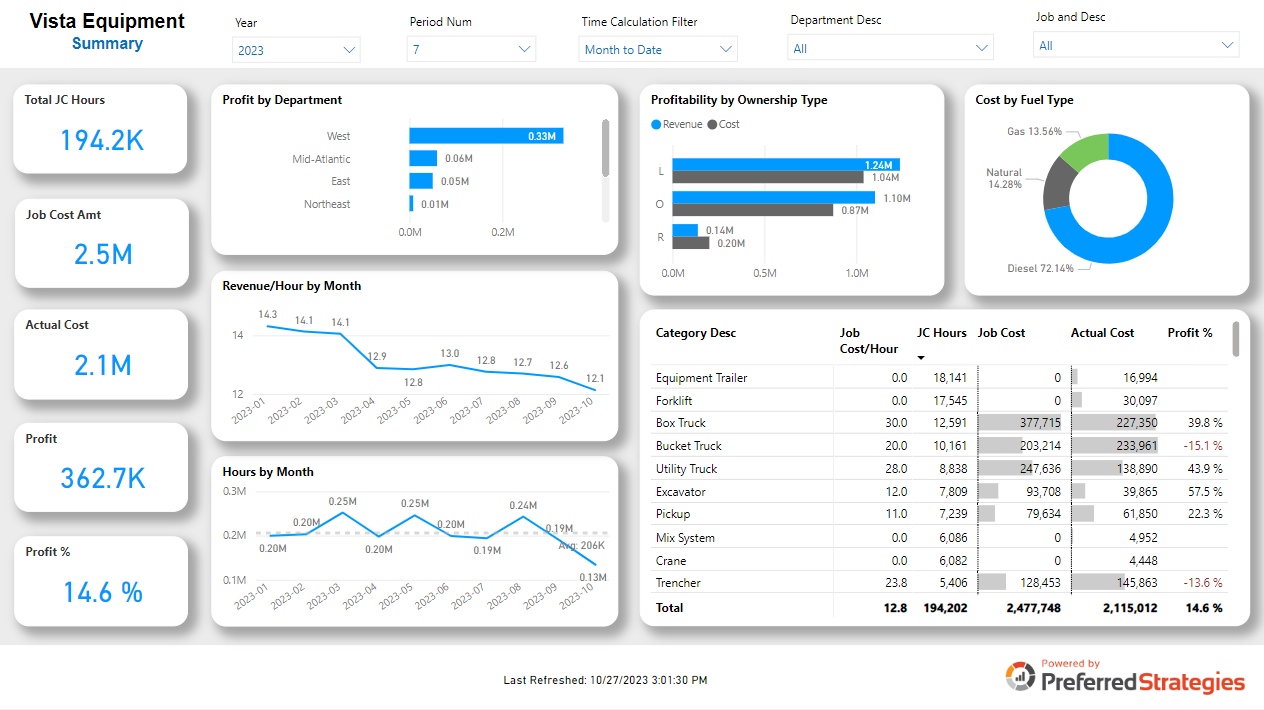
Make your Audit Teams Happy with Our New Compliance Perspective
Vista stores compliance records in three separate tables; Vendor Compliance, Purchase Order Compliance, and Subcontract Compliance. Our compliance perspective merges these separate tables into one to provide a comprehensive view so that all compliance requirements and statuses for a vendor or contract can be seen in one glance. This single version of compliance truth will allow AP staff to resolve invoice hold inquiries quickly and will also allow project management staff to put pressure on subcontractors and vendors before their compliance status expires which leads to risk reduction.Sign Up for QuickLaunch for Vista 5.2 Release Notes Webinar
[post_title] => QuickLaunch for Vista Release Notes: Payroll Detail, Equipment Maintenance, Warranty Details and Much More! [post_excerpt] => We’re always looking to make improvements here at QuickLaunch Analytics and lately, we’ve been busy! Vista Release Notes is our blog series that showcases recent product improvements to help you stay up to date on what’s new. [post_status] => publish [comment_status] => open [ping_status] => open [post_password] => [post_name] => vista-release-notes [to_ping] => [pinged] => [post_modified] => 2023-11-28 11:30:01 [post_modified_gmt] => 2023-11-28 19:30:01 [post_content_filtered] => [post_parent] => 0 [guid] => https://quicklaunchanalytics.com/?p=10693 [menu_order] => 0 [post_type] => post [post_mime_type] => [comment_count] => 0 [filter] => raw ) [7] => WP_Post Object ( [ID] => 10429 [post_author] => 6 [post_date] => 2023-06-29 09:47:29 [post_date_gmt] => 2023-06-29 16:47:29 [post_content] => For both business users consuming insights through the Power BI Service and developers designing reports in the Power BI Desktop, the continuous innovation going on at Microsoft these days within the Power BI and Azure Analytics product groups means there's a lot of updates to keep track of. In this on-going series we will comb thru all of the latest updates and provide you with an overview of the most important features that are relevant to common enterprise analytics scenarios and deployments. We do this in the form of a live presentation with demos as well as a blog with mini recorded demos. Click here to watch the corresponding live education session recording.
Power BI Consumers
Power BI Goes Green
Late last year, Power BI announced that it would switch its application accent coloring from yellow to teal in order to make it more accessible for users with disabilities. This color coincidentally (or not) also matches the color scheme for the new Fabric platform announced last month that will include Power BI. More on that to come soon but if you have started to see the green Fabric logo in the Power BI Service…this is why.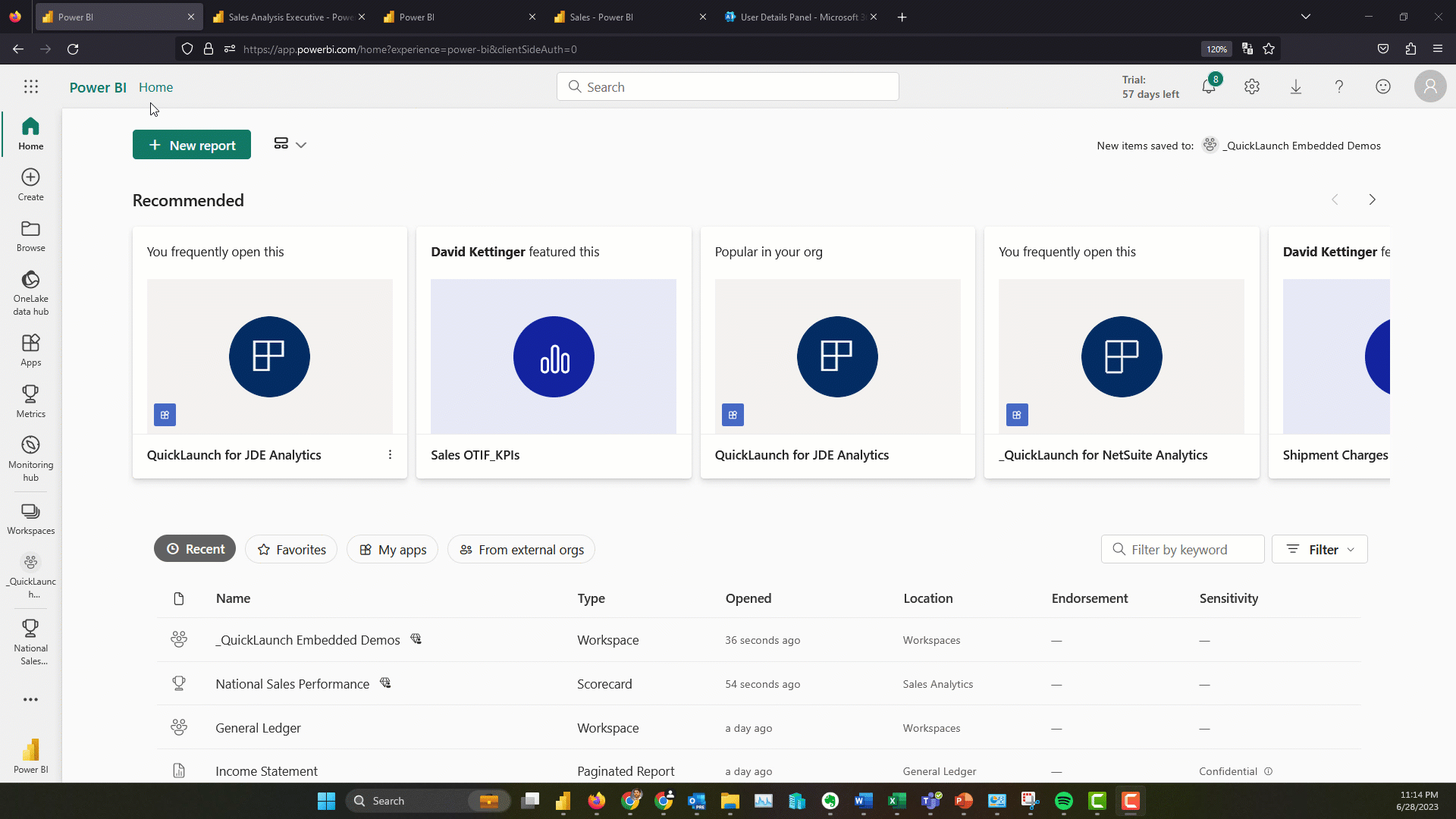 (click to view larger)
(click to view larger)
Subscribe to Personalized Views of Reports with Filters Applied
With the latest updates to the Subscribe feature, you can modify reports to be more relevant to yourself and then subscribe to that view. To do this, choose the Include my changes option in the Subscribe to emails window. This personalized view will include any of the following changes: filters, slicers, personalize visuals, cross-filtering or cross-highlighting, drill down or drill up, and spotlight. Read more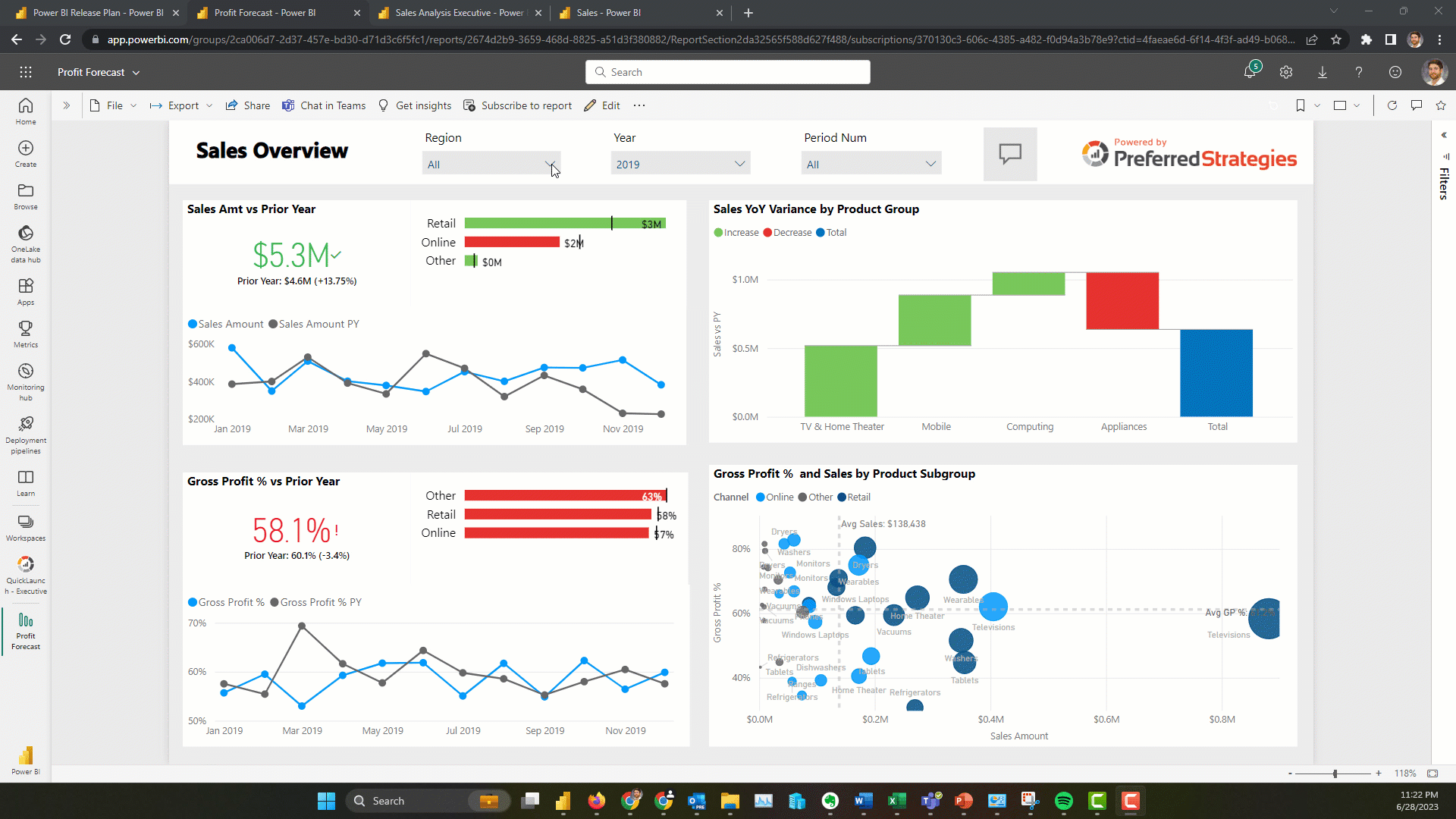 (click to view larger)
(click to view larger)
Enhanced Integration Between Power BI and PowerPoint
In past iterations of this presentation/blog we showed you how you can embed Power BI reports into a presentation using the Power BI Add in for PowerPoint. Taking that a step further, you can now embed single visualizations that pertain to your slide. This allows people to easily make their presentations more interactive and informative. To do this simply click the Share option in the visual menu and then paste the provided link into the PBI Add in dialog box. Read more (click to view larger)
(click to view larger)

Power BI Designers
Quick Measure Suggestions (Preview Feature)
Building on the Quick Measures feature that was introduced a few years ago, the Power BI team has introduced natural language query technology into the fold to automatically generate DAX code suggestions to users. This accelerates the learning curve to get started with creating measures in Power BI and is a taste of what’s to come with Copilot generative AI features coming soon. This doesn’t mean that you don’t need to take some DAX classes or validate and test your measures in addition to having a formalized process for introducing these into your company’s centralized data model. Read more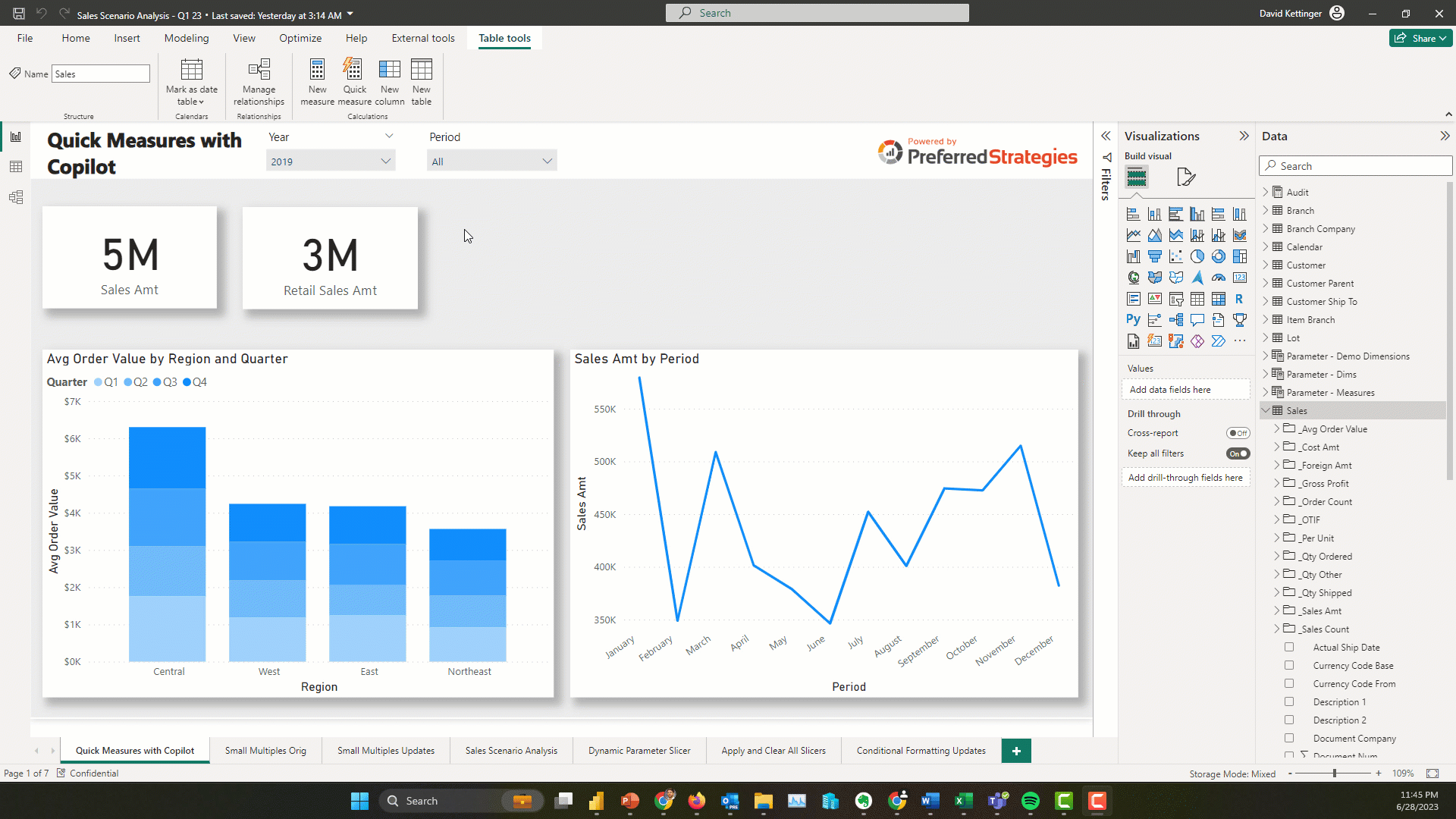 (click to view larger)
(click to view larger)
Enhanced Report Authoring with the Optimize Ribbon
With the new Optimize ribbon, report creators can improve both the development process and the consumer process through three new features that were combined with the Performance Analyzer feature. The first is the Pause visuals button which stops Power BI from sending queries while you are making changes to your report. Next up are Optimization Presets. These allow you to apply different settings combinations for Query Reduction, maximum Interactivity, or a custom blend of settings that works best for your needs. Lastly, the new ribbon allows you to add an Apply All Slicers button to a report that will turn off the visual refresh while users are making slicer value selections. These features are particularly useful for users who are working with very large datasets or a Direct Query report and need to optimize the user experience or for scenarios where consumers request many slicers which can slow down report performance. Read more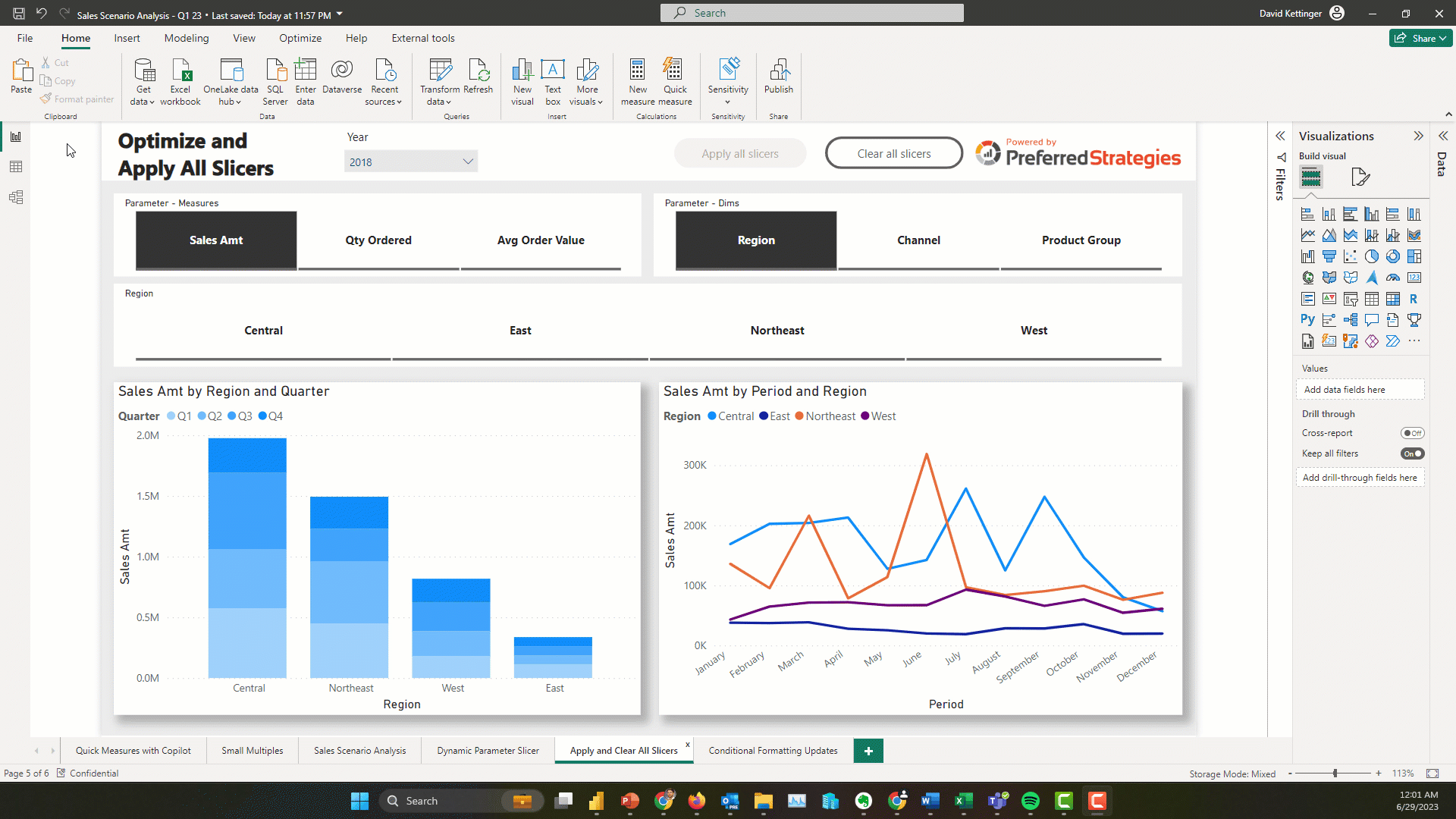 (click to view larger)
(click to view larger)
Improvements to the Small Multiple Visual
The Small Multiple Visual was a great addition to the visualization suite in Power BI but it had a few gaps when released including making it more legible as you scaled the number of multiples. Fortunately, this has been addressed with the ability to unsynchronized the axes and scale each chart individually. This is accomplished by unsharing the y-axes and enabling the scale to fit option. Read more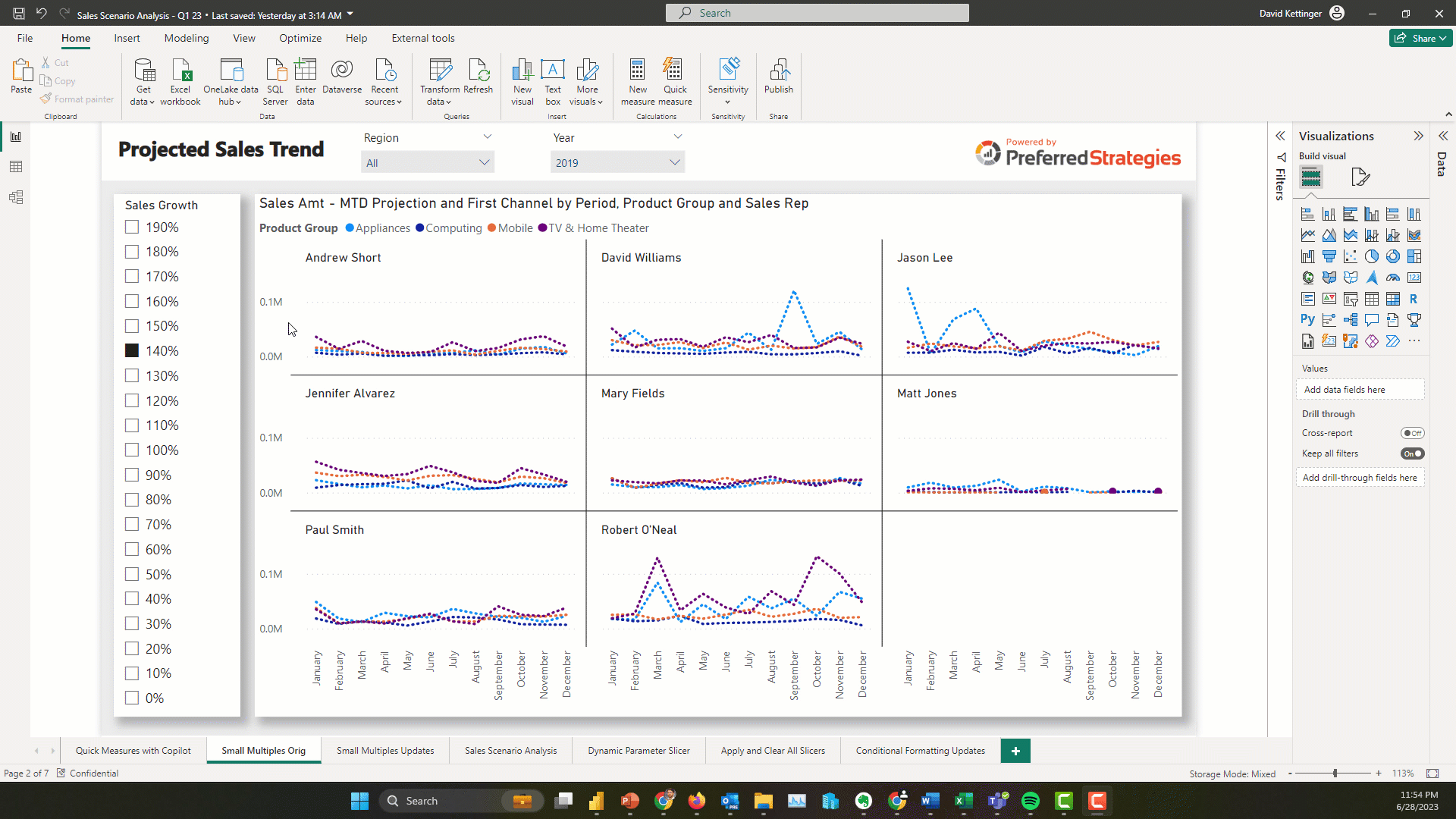 (click to view larger)
(click to view larger)
Create Dynamic Slicers with the New Field Parameter Feature
In the last iteration of this blog/presentation (link to blog), we demonstrated how you can use the Field Parameter feature in PBI to create dynamic visualizations and perform scenario analyses. With the latest update to this feature, you can now create dynamic slicers to allow users to slice by the values of the dimension parameter slicer. To do this you need to copy and paste the dimension parameter slicer and choose the option to show the values of the selected field in the field well. Read more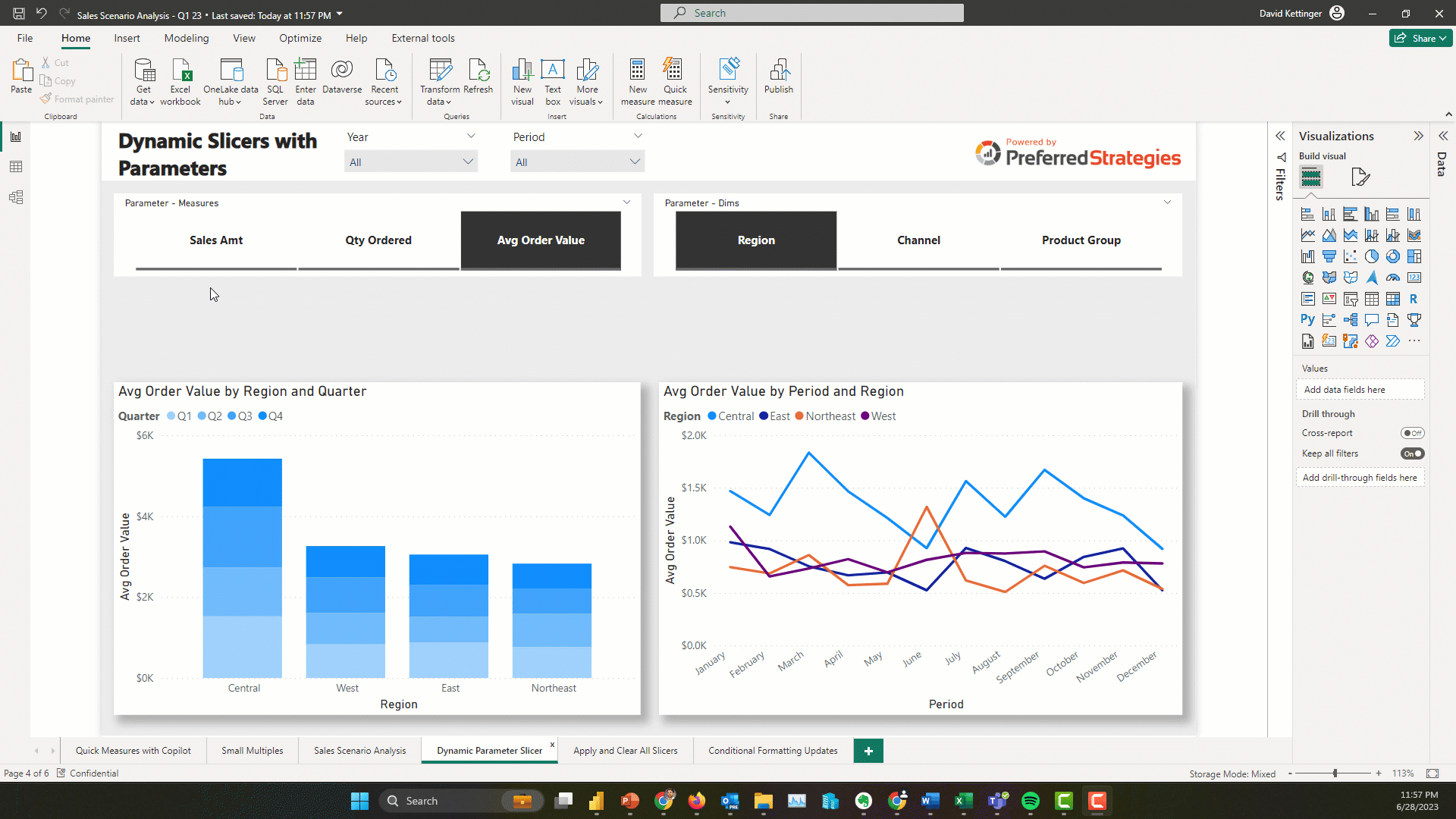 (click to view larger)
(click to view larger)
Conditionally Format Visual Elements based on Text/String Fields
This is an exciting update because in the past the standard options only included support for numeric based conditional formatting and in order to accomplish this you had to do some fancy footwork in DAX adding new fields that linked string values to color codes. Now you just have to choose the format by Rules option and select the string field you want to use and list the value in the rule dialog box. Read more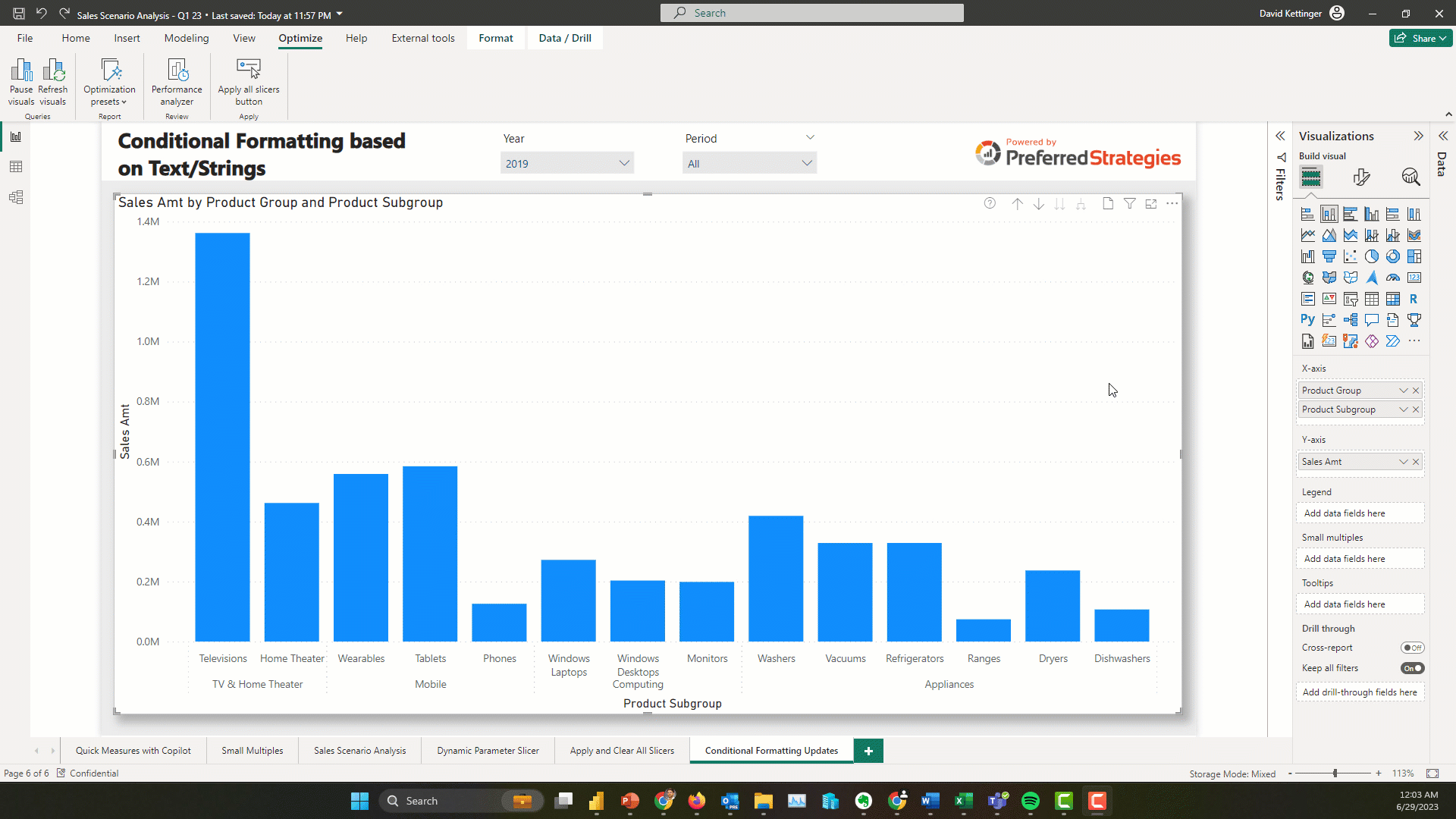 (click to view larger)
(click to view larger)
Smart Narrative Feature Built in for Visual Summaries
Power BI introduced its Natural Language Generation feature, Smart Narratives, a couple years ago but up until now you had to create a dedicated visual on your canvas to house this written analysis. However with this update you can enable your consumers to get these ML generated features on demand for each visual on your page to expose new insights. To enable for your report, simply click on the visual and then enable the Smart Narrative icon in the Format pane. Read moreUpdate to Page Navigator Visual
No more hiding and unhiding pages in your report! Now you can easily choose with pages to include or not include using the Pages section of the formatting pane. This feature is especially useful if you have a lot of pages in your report. Read more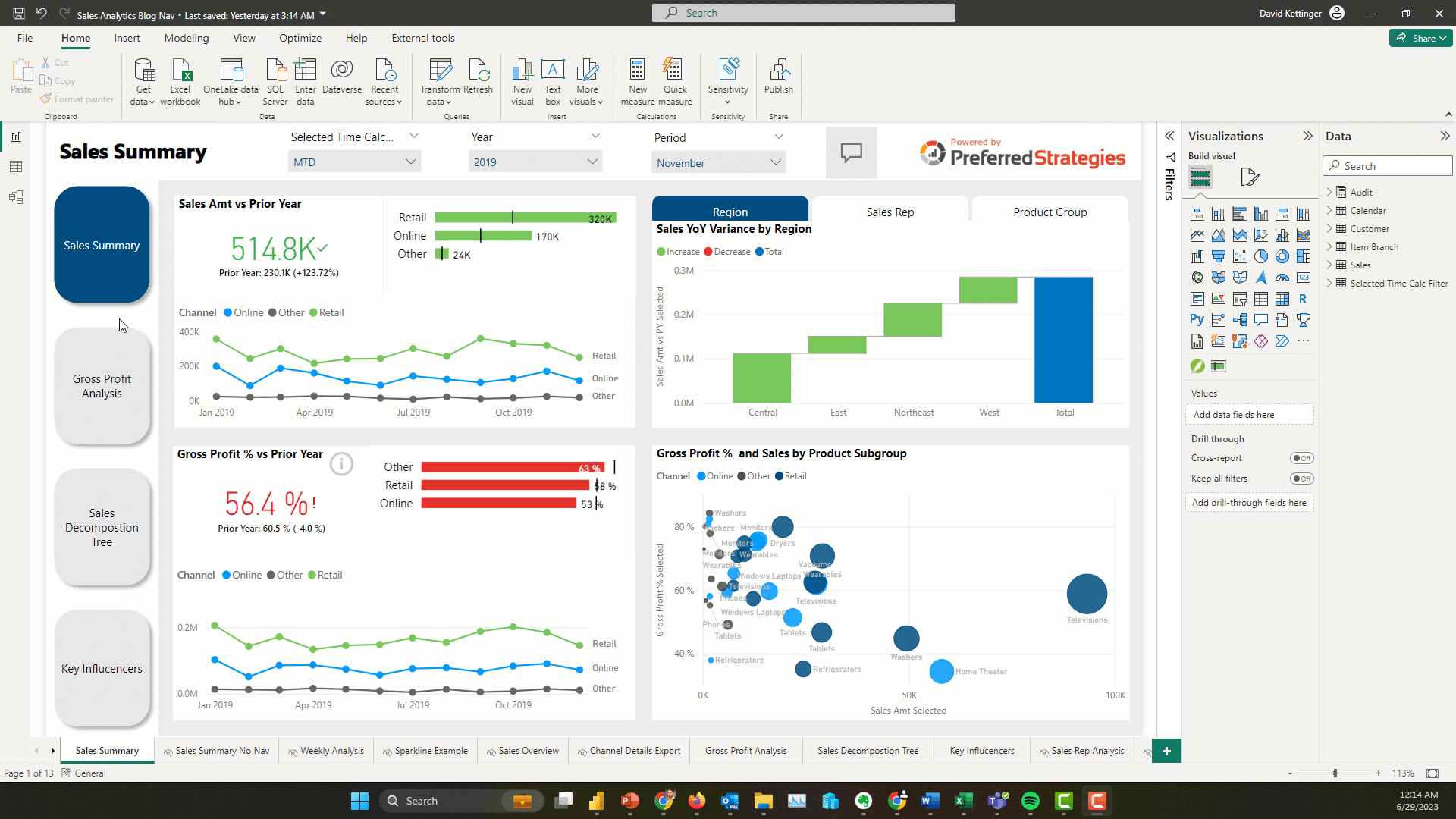 (click to view larger)
(click to view larger)
Enhance Your Visual Containers with New Subtitles, Dividers, Spacing and Padding Settings
In the last iteration of this blog/presentation (link to blog), we demonstrated how you can use the Field Parameter feature in PBI to create dynamic visualizations and perform scenario analyses. With the latest update to this feature, you can now create dynamic slicers to allow users to slice by the values of the dimension parameter slicer. To do this you need to copy and paste the dimension parameter slicer and choose the option to show the values of the selected field in the field well. Read more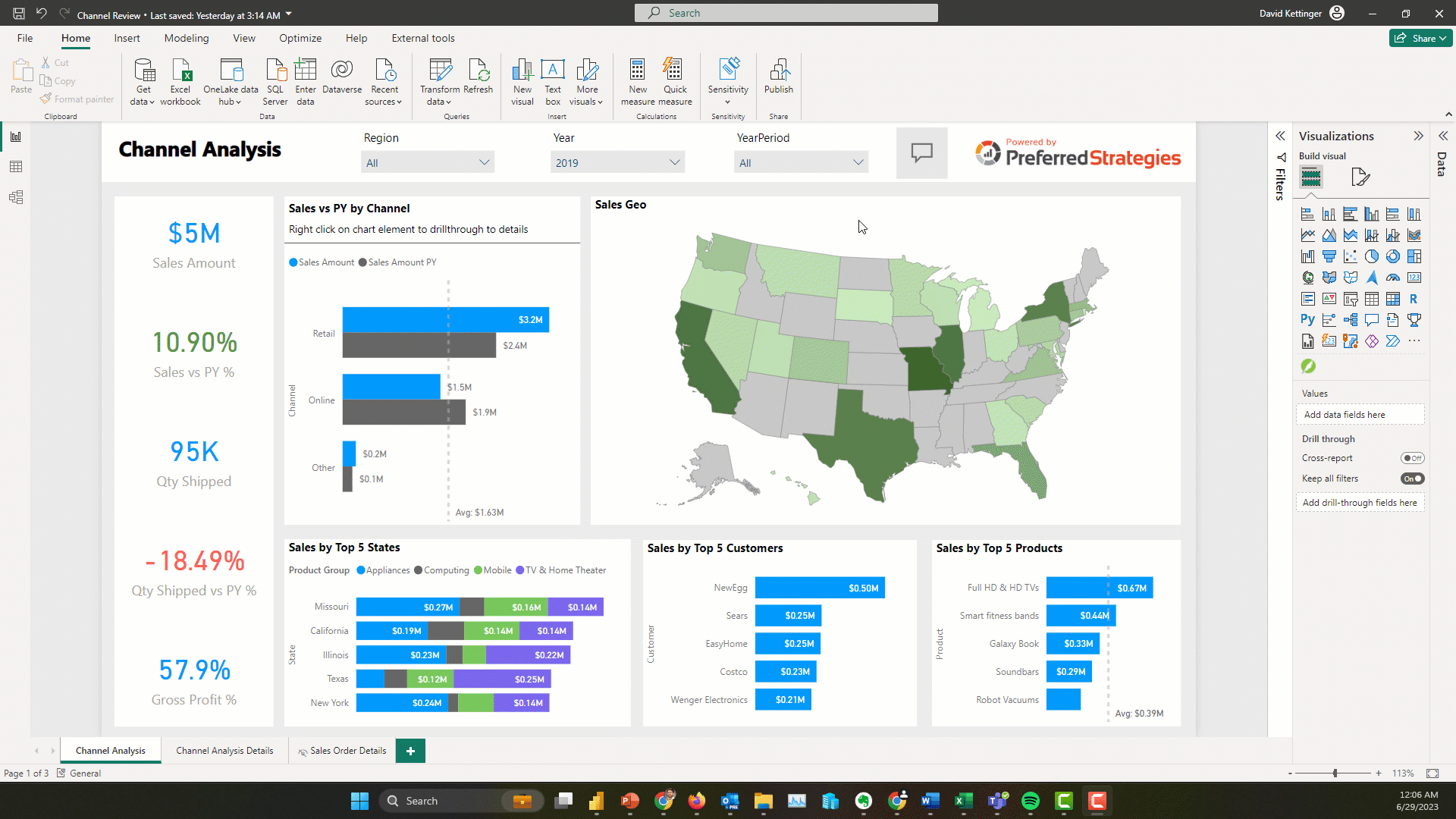 (click to view larger)
(click to view larger)

Power BI Admins & Content Managers
Paginated Reports Supported for Power BI Pro Workspaces
Before late last year, Paginated Reports were only supported in Premium workspaces but that restriction has been lifted and you can now publish these traditional operational style reports with a Pro license. In addition, there is a new migration tool as part of SQL Server 2022 that will help customers migrate SSRS reports to the Power BI Service which can help free up resources on your SQL server instances. These two updates should allow most companies to start using Paginated Reports alongside there interactive Power BI reports. Read more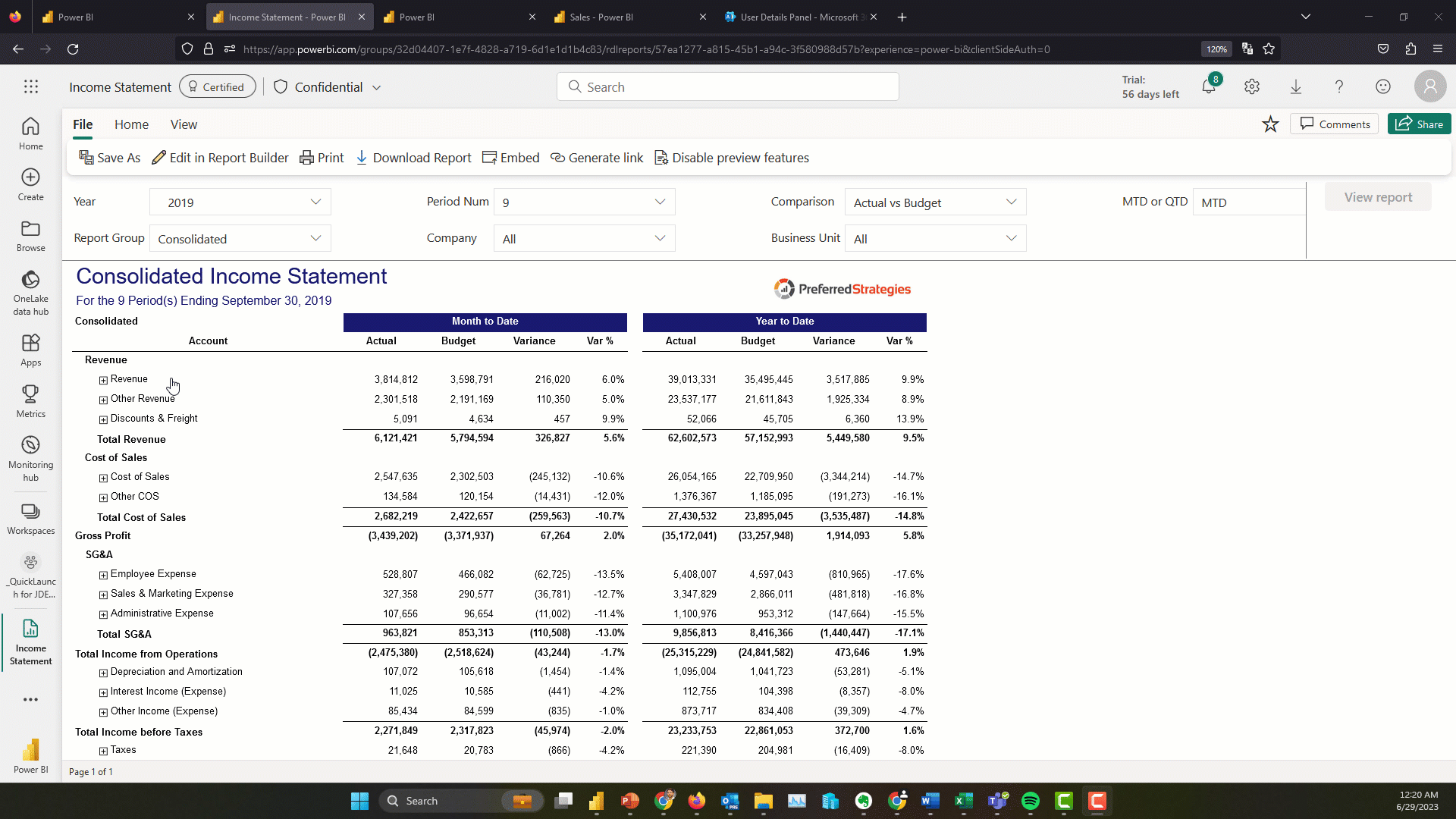 (click to view larger)
(click to view larger)
Allow Email Subscriptions to be Sent to External Users (Premium Feature)
If content is backed by either a Premium Capacity or Premium Per User license, users can set up subscriptions for external users that are not inside your company and haven’t been invited to your Azure AD B2B directory. You can control which users and security groups have access to this or to disable the feature in the tenant settings section of the Admin Portal. Read more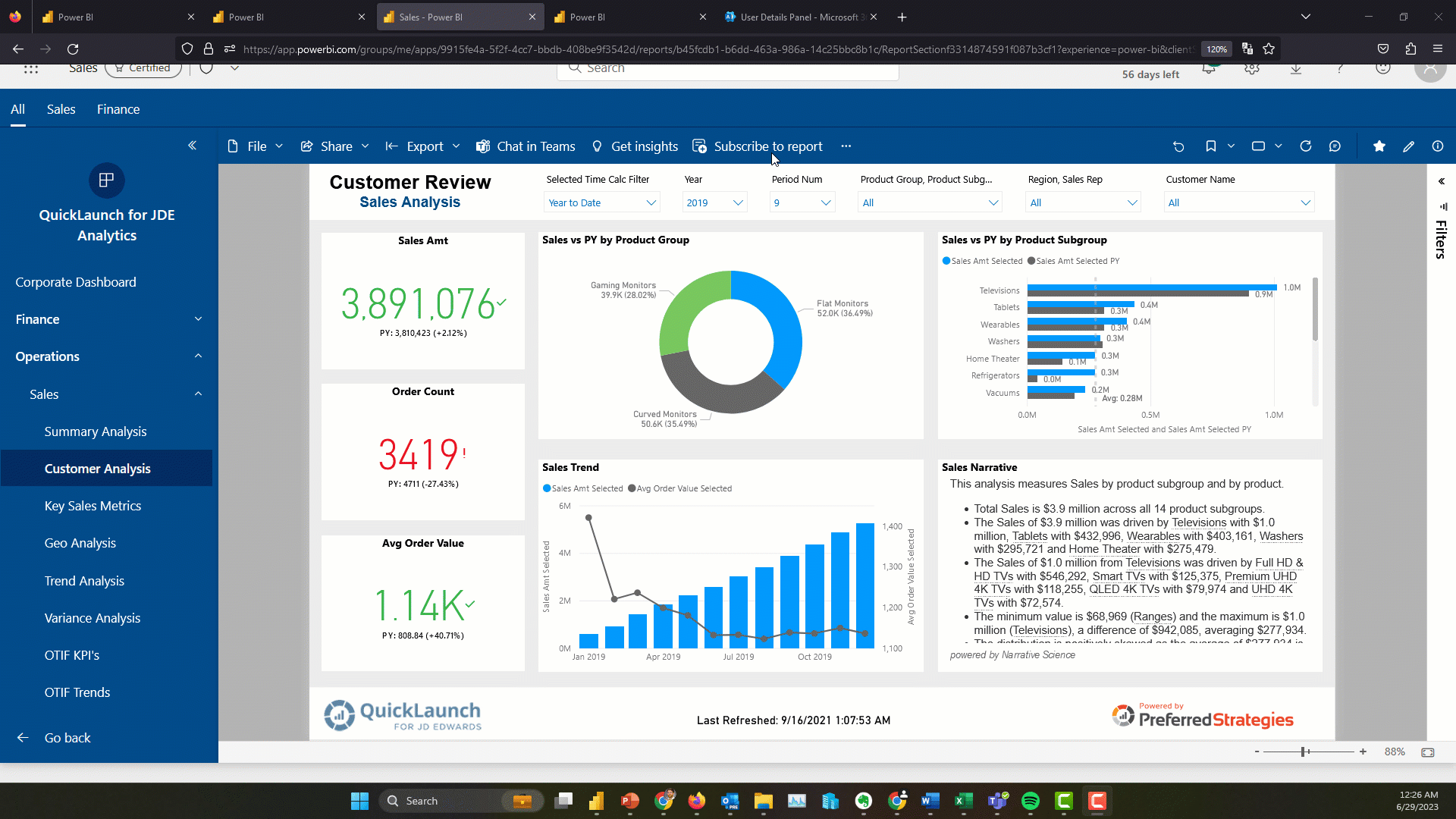 (click to view larger)
(click to view larger)
Improved Way to Upload and Manage Power BI and Excel Files
There’s a new way to upload Power BI Excel files in Power BI and it’s much better. The UX has changed and now there is a drop down for Upload in the top of the workspace screen where you can choose to upload a file from Sharepoint or OneDrive for Business as well as Browsing your pc for a local file. The advantage of Sharepoint and OneDrive method is that your saved changes from PBI Desktop are saved automatically about every hour. Read more (click to view larger)
(click to view larger)
Intro to Fabric and Enabling the new Fabric Platform for Your Tenant (Preview Feature)
Fabric is the new end-to-end cloud analytics platform from Microsoft that includes a Data Factory-powered data integration experience, Synapse-powered data engineering, data warehouse, data science, and real-time analytics experiences and business intelligence (BI) with Power BI; all connected to one data lake (OneLake) and delivered as a SaaS solution. Stay tuned for the next iteration of this PBI updates series where we will peel back the different layers of Fabric and discuss their readiness for enterprise analytics as well as provide demonstrations over QuickLaunch data. In the meantime, if you’re a PBI Admin, you can choose to turn on the Fabric platform preview for your tenant, by enabling the new corresponding tenant setting. If you don’t choose to opt out by July 1st, 2023, it will automatically be turned on. If you do opt out before then, it will stay off until you enable it. For customers running Power BI Premium capacities through P SKUs, the new Fabric experiences will not affect your resource usage on your capacity before August 1st, 2023. Starting in June, the Power BI Administrator Role will be renamed the Fabric Administrator to align with changing scope of new platform. Starting in June, the Power BI Free license will be renamed to the Microsoft Fabric (Free) license. Read more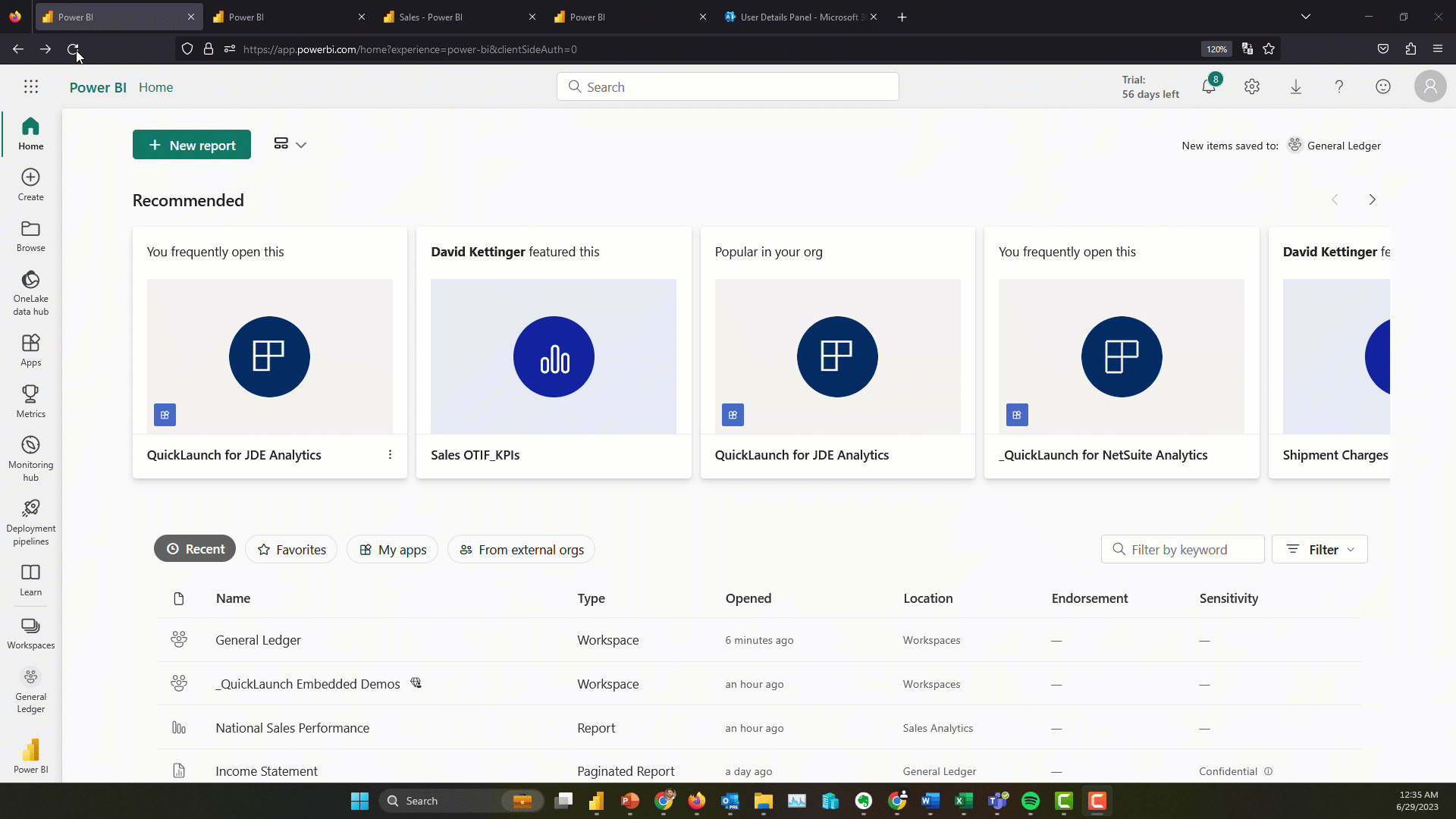 (click to view larger)
That wraps up this installment of the Power BI updates blog. Join us for Part 2 of this presentation on July 20th by registering here. If you're interested in checking out the Power BI feature release plan in an interactive Power BI report click here.
[post_title] => Power BI Updates for Enterprise Analytics: Q2 2023 - Part 1
[post_excerpt] => As we move towards the holiday season, let's review what the Power BI team has been up to over the summer and early fall of 2023.
[post_status] => publish
[comment_status] => closed
[ping_status] => open
[post_password] =>
[post_name] => power-bi-updates-q1-2023
[to_ping] =>
[pinged] =>
[post_modified] => 2023-08-18 09:04:25
[post_modified_gmt] => 2023-08-18 16:04:25
[post_content_filtered] =>
[post_parent] => 0
[guid] => https://quicklaunchanalytics.com/bi-blog/power-bi-updates-q3-2021-copy/
[menu_order] => 0
[post_type] => post
[post_mime_type] =>
[comment_count] => 0
[filter] => raw
)
[8] => WP_Post Object
(
[ID] => 10252
[post_author] => 10
[post_date] => 2022-10-12 07:23:19
[post_date_gmt] => 2022-10-12 14:23:19
[post_content] =>
(click to view larger)
That wraps up this installment of the Power BI updates blog. Join us for Part 2 of this presentation on July 20th by registering here. If you're interested in checking out the Power BI feature release plan in an interactive Power BI report click here.
[post_title] => Power BI Updates for Enterprise Analytics: Q2 2023 - Part 1
[post_excerpt] => As we move towards the holiday season, let's review what the Power BI team has been up to over the summer and early fall of 2023.
[post_status] => publish
[comment_status] => closed
[ping_status] => open
[post_password] =>
[post_name] => power-bi-updates-q1-2023
[to_ping] =>
[pinged] =>
[post_modified] => 2023-08-18 09:04:25
[post_modified_gmt] => 2023-08-18 16:04:25
[post_content_filtered] =>
[post_parent] => 0
[guid] => https://quicklaunchanalytics.com/bi-blog/power-bi-updates-q3-2021-copy/
[menu_order] => 0
[post_type] => post
[post_mime_type] =>
[comment_count] => 0
[filter] => raw
)
[8] => WP_Post Object
(
[ID] => 10252
[post_author] => 10
[post_date] => 2022-10-12 07:23:19
[post_date_gmt] => 2022-10-12 14:23:19
[post_content] => Silicon Valley-based software reporting, analytics, and business intelligence company now offers a four-week trial offering of its signature product to JD Edwards users
Soquel, CA - QuickLaunch Analytics, a leader in data transformation, modern business intelligence, and data analytics innovation, today announced its industry unique four-week trial offering of QuickLaunch Test Drive is now available. QuickLaunch Test Drive is designed to help forward-thinking companies running JD Edwards (JDE) learn how to improve the way data can be accessed and analyzed throughout their organization. It also allows these companies to experience how modern business intelligence (BI) technologies like Microsoft Power BI can work best when implemented over their own JDE data.Microsoft Power BI is consistently recognized as the “go to” platform in the marketplace. In the latest Gartner Magic Quadrant for Analytics and Business Intelligence (BI) Platforms, Power BI was the clear leader once again and Microsoft has been in the Leaders quadrant for the past 14 years. During the past six years, Power BI has been adopted by more than 250,000 organizations including 97 percent of Fortune 500 companies. For companies that already leverage Power BI, but haven’t harnessed its full potential, or those that are interested in experiencing its benefits for the first time, the QuickLaunch Test Drive program is a great place to start.
“If you run JDE as your ERP and want to know how successfully implementing a Modern BI, Reporting, and Analytics technology like Power BI will change the way your company thinks about and operates around data, the QuickLaunch Test Drive is perfect for you,” said Adam Crigger, Founder and President, QuickLaunch Analytics. “As many companies lack the awareness of how Power BI can improve operational efficiencies, team-member satisfaction, and increase profitability, we wanted to find a way for customers to experience this for themselves and the QuickLaunch Test Drive does just that. During the trial, we will transform your JDE General Ledger and/or Sales data into actionable information, identify patterns in your data instantaneously, and shorten report development times.”
QuickLaunch Test Drive program participants will have access for up to four weeks. Throughout the program, QuickLaunch Analytics will provide hands-on education workshops and working sessions for your report authors around Sales and/or General Ledger, and provide a preview and introduction for executives. Those who take advantage of the QuickLaunch Test Drive over their live JD Edwards data will experience firsthand the positive impact and transformation the QuickLaunch Analytics solution can have on their operations and organization.
After the completion of the QuickLaunch Test Drive program, for a limited time, 100 percent of the set up fee will be credited back to the customer upon receipt of a signed agreement within 30-days after the program.
To understand what the QuickLaunch Test Drive program can do for your organization:
- Visit https://quicklaunchanalytics.com/trial/
- email info@quicklaunchanalytics.com
- or call 1-888-232-7337
About QuickLaunch Analytics
QuickLaunch Analytics was founded in 2002 by experienced JD Edwards business users and IT professionals. While working at a large construction materials and contracting company, QuickLaunch Analytics’ Founder & President, Adam Crigger, experienced firsthand the difficulty in extracting data from JD Edwards and translating that data into meaningful reports and analytics. Today, QuickLaunch Analytics is helping hundreds of JD Edwards, Viewpoint Vista, and Salesforce customers realize the full potential of their ERP and CRM data through the innovative QuickLaunch Analytics QuickLaunch product. Combining decades of business and technical experience working with JD Edwards, NetSuite, Viewpoint Vista, and Salesforce data and modern reporting tools such as Microsoft® Power BI, QuickLaunch delivers the framework every customer needs to succeed on their data driven journey. For more information, visit https://www.quicklaunchanalytics.com. [post_title] => QuickLaunch Analytics Invites JD Edwards Users to Take a QuickLaunch Test Drive [post_excerpt] => Silicon Valley-based software reporting, analytics, and business intelligence company expands and enhances its QuickLaunch product line to meet increasing marketplace demand. [post_status] => publish [comment_status] => closed [ping_status] => open [post_password] => [post_name] => quicklaunch-test-drive-for-jde-users [to_ping] => [pinged] => [post_modified] => 2025-08-01 12:53:58 [post_modified_gmt] => 2025-08-01 19:53:58 [post_content_filtered] => [post_parent] => 0 [guid] => https://quicklaunchanalytics.com/bi-blog/20-year-growth-copy/ [menu_order] => 0 [post_type] => post [post_mime_type] => [comment_count] => 0 [filter] => raw ) ) [post_count] => 9 [current_post] => -1 [before_loop] => 1 [in_the_loop] => [post] => WP_Post Object ( [ID] => 12588 [post_author] => 6 [post_date] => 2025-08-01 15:56:38 [post_date_gmt] => 2025-08-01 22:56:38 [post_content] => In today's economy, you expect your business to be taxed on its profits, its property, and its payroll. But there’s another, more insidious tax that most organizations pay without even realizing it—a hidden expense that drains resources, stifles innovation, and quietly sabotages your success. The hidden costs of data silos. It's called the Data Silo Tax. This is the cumulative cost your business pays every single day for operating with a fragmented, disconnected data environment. When each department—from finance and operations to sales and marketing—runs on its own island of information, the tax shows up in wasted payroll, flawed strategies, and missed opportunities. It is the price of not having a single source of truth, and that price is far higher than most leaders imagine. The first step to eliminating this tax is understanding how, and how much, you’re paying.The Telltale Signs: Are You Paying the Data Silo Tax?
If you're wondering whether this hidden tax is impacting your organization, review this checklist of common symptoms. The more questions you answer "yes" to, the higher the tax you're likely paying:- Do your teams spend the first hour of every strategic meeting debating whose numbers are correct?
- Is "I'll have to get back to you on that" the most common answer when leaders ask for a specific data point?
- Do your analysts spend more time exporting data to spreadsheets and manually reconciling reports than they do on actual analysis?
- Have you ever launched a product or initiative based on one department's data, only to be blindsided by its unforeseen impact on another department?
- Does your IT department manage multiple, overlapping BI and reporting tools for different teams?
- Have promising AI or machine learning initiatives stalled because the data was too difficult to access, clean, and connect?
A Deeper Dive into the 5 Hidden Data Fragmentation Costs
1. The Tax on Productivity and Labor At its most basic level, the data silo tax is a direct drain on your payroll. Consider the daily reality for a skilled financial analyst or operations manager in a fragmented data environment. Their day begins not with strategic analysis, but with a series of manual, low-value tasks. They have to log into multiple systems, export raw data to spreadsheets, and then manually attempt to stitch it all together, hoping the date formats and customer names line up. This isn't just inefficient; it's a profound waste of your most valuable talent. Instead of leveraging their expertise to uncover insights and drive growth, they are forced to act as human data integrators. A study by Anaconda found that data scientists spend a staggering 45% of their time on data preparation and cleaning alone.1 This "data janitor" work is a direct productivity tax, leading to employee burnout, error-prone analysis, delayed projects, and a significant inflation of your operational costs.2. The Tax on Decision-Making and Opportunity
The most damaging cost of the data silo tax is often the one that never appears on a balance sheet: the cost of a bad decision. When a CFO cannot get a real-time, consolidated view of cash flow across all business units, they may make a conservative capital allocation decision that causes them to miss a critical growth opportunity. When a COO lacks end-to-end supply chain visibility, they cannot proactively respond to a disruption in one region before it cascades into a massive, customer-impacting problem in another. In a siloed environment, leaders are forced to make decisions with incomplete, outdated, or contradictory information. This creates a culture of hesitation, where gut feel and anecdote have to fill the gaps left by unreliable data. The true cost isn't just the bad decisions you make; it's the game-changing, proactive decisions you never have the confidence to even consider.3. The Tax on Trust
When the sales team’s report on quarterly bookings and the finance team’s report on recognized revenue tell two completely different stories, a toxic data credibility crisis is born. Business users quickly learn to mistrust the numbers. Every dashboard is viewed with skepticism, and every new report is met with a barrage of questions about the data’s origin and accuracy. This erodes the very foundation of a data-driven culture. It undermines investments in analytics tools and training, as users revert to their own departmental spreadsheets because they are the only numbers they feel they can control. The tax on trust is a corrosive force that makes it nearly impossible to align the organization around common goals and objective facts, ensuring that strategic conversations remain mired in opinion rather than evidence.4. The Tax on IT and Technology
For the IT department, data silos create a complex, inefficient, and expensive nightmare. To support each departmental island, IT is forced to purchase, implement, and maintain a patchwork of redundant and overlapping BI and reporting tools. The finance team has their preferred system, marketing uses another, and operations has a third. This bloated and fragmented tech stack is a massive drain on the IT budget and a source of significant technical debt. IT staff spend their time on low-value maintenance and integration "band-aids" instead of focusing on high-impact innovation. Furthermore, this brittle environment is a security risk, with inconsistent access controls and data governance policies across dozens of systems creating a wide and vulnerable threat surface.5. The Tax on Innovation
Perhaps most critically, a fragmented data foundation makes it impossible to compete in the modern era of analytics. You simply cannot build the future of your business on a broken foundation. Advanced capabilities like Artificial Intelligence (AI) and Machine Learning (ML) are not magic; they are powerful tools that require vast amounts of clean, connected, high-quality data to function. Without a unified data source, your AI initiatives will be limited to narrow, experimental use cases with little potential for transformative impact. Meanwhile, your competitors who have solved their data fragmentation problems are already leveraging AI to create significant competitive advantages. The tax on innovation is the gap between where your business is and where it needs to be to survive and thrive in the coming years.How to Quantify the Tax in Your Organization
The Data Silo Tax is more than a concept; it's a real number impacting your bottom line. To begin quantifying it, leaders should ask their teams the following questions. The answers will help you build a business case for change by revealing the true cost of fragmentation.- Audit Your Technology Spend: How much are we spending on redundant, overlapping BI and reporting tools across different departments? What is the annual cost of the licenses, subscriptions, and maintenance for all of them combined?
- Track Your Team's "Wasted" Time: How many hours do our skilled analysts and managers waste each week manually finding, cleaning, and reconciling data instead of performing high-value analysis? (Multiply these hours by a loaded hourly rate to get a direct labor cost).
- Measure Your "Time-to-Decision": How long does it take, on average, to get a trusted answer to a critical, cross-functional business question? What is the business cost of that delay?
- Evaluate Your Strategic Agility: Can we identify specific market opportunities we missed or were slow to react to because of a lack of accessible, comprehensive data?
Case in Point: How Unified Data Generated an $8M Annual Return
The costs of the Data Silo Tax are real, but so are the returns from eliminating it. Consider the case of The International Group (IGI), a leader in the wax industry. The Challenge: IGI's primary challenge was a lack of a centralized location for their enterprise data. Their critical ERP and manufacturing systems operated in separate silos, making a single, comprehensive view of their operations impossible. This fragmentation meant that true, cross-functional business intelligence was out of reach, and any forward-looking AI or machine learning initiatives were non-starters. Without a solid, unified data foundation, they couldn't leverage their data as a strategic asset. The Solution: IGI implemented a unified analytics platform, connecting their ERP and manufacturing systems into a single source of truth. This gave their engineers and operators immediate, self-service access to the data they needed to analyze results and advise on process changes in the moment. The Results: The transformation was staggering.- A Foundation for Innovation: With clean, connected data, IGI was able to apply machine learning and AI to their manufacturing process.
- Massive Financial Impact: By analyzing this unified data, the AI models were able to identify optimal settings that reduced manufacturing waste from 8% to 4%, directly increasing profit by $8-10 million per year.
The Path Forward: A Glimpse into the Blueprint for Success
Escaping the Data Silo Tax requires a deliberate shift from fragmented reporting to a unified Enterprise Intelligence strategy. This journey, which turned IGI's data into a multi-million dollar asset, follows a proven, three-step framework.- Connect: The journey begins by creating automated data pipelines to reliably replicate information from all your disparate data sources. This replaces manual data extraction and ensures a consistent, timely flow of information from your core enterprise systems.
- Centralize: Next, you must consolidate this data into a modern, AI-ready data foundation, like a data Lakehouse. This provides a single, scalable, and governed home for all your enterprise data, creating the prerequisite for both trustworthy BI, AI, and advanced analytics.
- Conquer: Finally, you must transform the centralized data into actionable intelligence with an enterprise-grade semantic model. This is the crucial translation layer that applies business logic and makes the data accessible, understandable, and useful for every business user, from the shop floor to the C-suite.
Your Detailed Blueprint for a Unified Future
This framework provides a clear path to eliminating data silos and reclaiming the costs of a disconnected business. To help you execute this plan, we've created a comprehensive, step-by-step guide. Ready to Stop Paying the Data Silo Tax? Download our free ebook, "Connect. Centralize. Conquer. Your Blueprint for Achieving Enterprise-Wide Intelligence," and get the actionable plan you need to build a unified data foundation and drive your business into the future. [DOWNLOAD YOUR BLUEPRINT NOW] References: [post_title] => The Data Silo Tax: Calculating the Hidden Costs of Data Silos [post_excerpt] => [post_status] => publish [comment_status] => open [ping_status] => open [post_password] => [post_name] => costs-of-data-silos [to_ping] => [pinged] => [post_modified] => 2025-08-12 15:23:37 [post_modified_gmt] => 2025-08-12 22:23:37 [post_content_filtered] => [post_parent] => 0 [guid] => https://quicklaunchanalytics.com/?p=12588 [menu_order] => 0 [post_type] => post [post_mime_type] => [comment_count] => 0 [filter] => raw ) [comment_count] => 0 [current_comment] => -1 [found_posts] => 113 [max_num_pages] => 13 [max_num_comment_pages] => 0 [is_single] => [is_preview] => [is_page] => [is_archive] => [is_date] => [is_year] => [is_month] => [is_day] => [is_time] => [is_author] => [is_category] => [is_tag] => [is_tax] => [is_search] => [is_feed] => [is_comment_feed] => [is_trackback] => [is_home] => 1 [is_privacy_policy] => [is_404] => [is_embed] => [is_paged] => [is_admin] => [is_attachment] => [is_singular] => [is_robots] => [is_favicon] => [is_posts_page] => [is_post_type_archive] => [query_vars_hash:WP_Query:private] => 822db949fe6ac144cd43eb1d65b76381 [query_vars_changed:WP_Query:private] => [thumbnails_cached] => [allow_query_attachment_by_filename:protected] => [stopwords:WP_Query:private] => [compat_fields:WP_Query:private] => Array ( [0] => query_vars_hash [1] => query_vars_changed ) [compat_methods:WP_Query:private] => Array ( [0] => init_query_flags [1] => parse_tax_query ) [query_cache_key:WP_Query:private] => wp_query:326c762db82d704ddd133a35be8de60e:0.64395500 1755612776 )
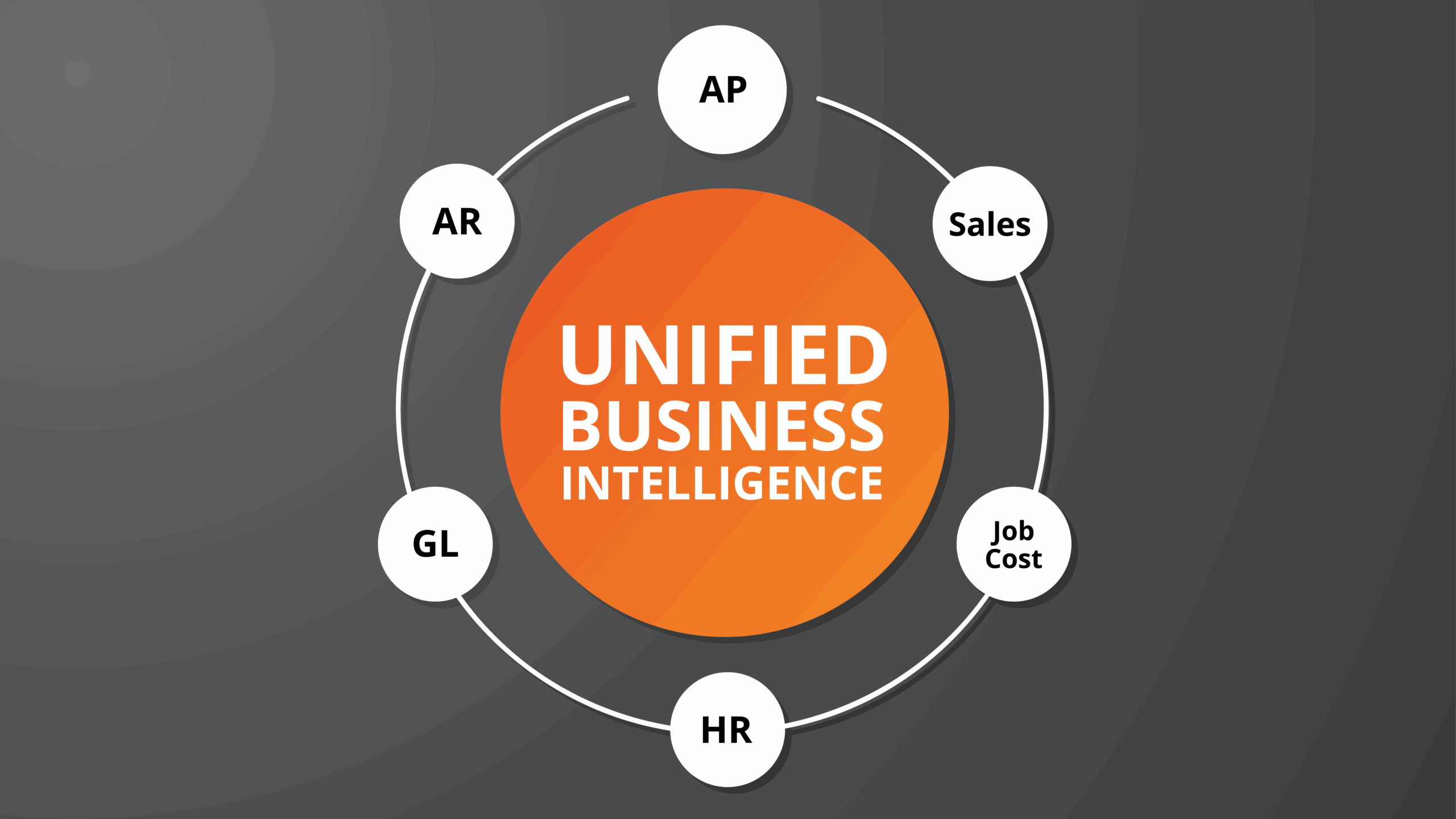
The Definitive Guide to Enterprise BI Integration: From Strategy to Execution
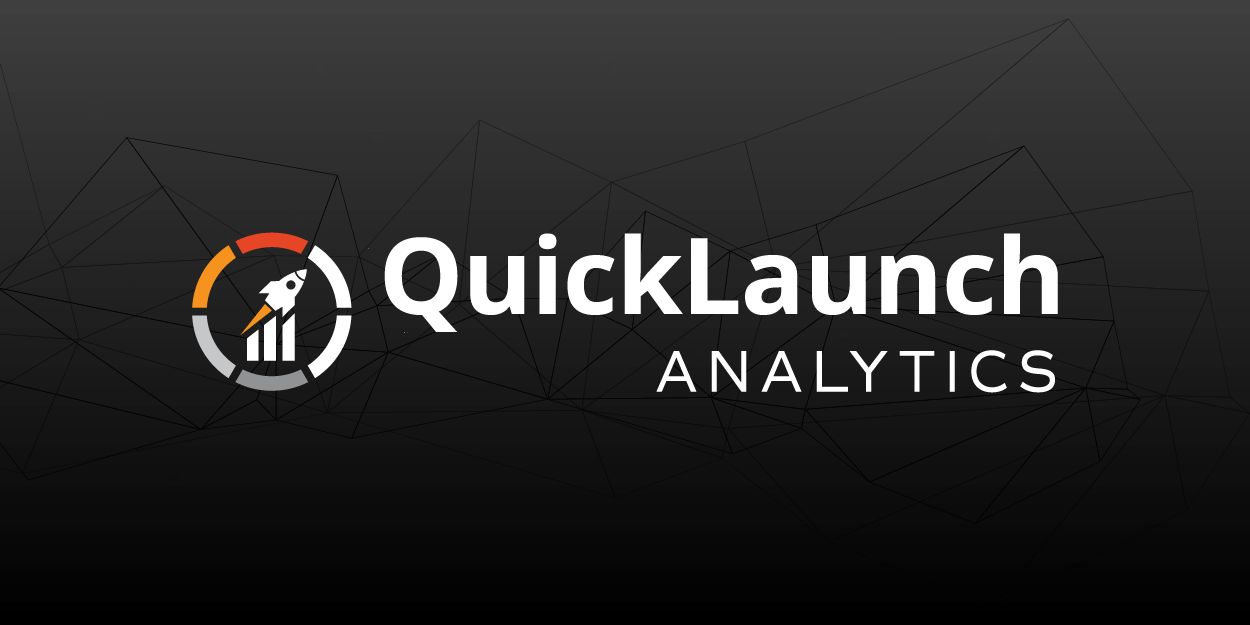
CCC EBook
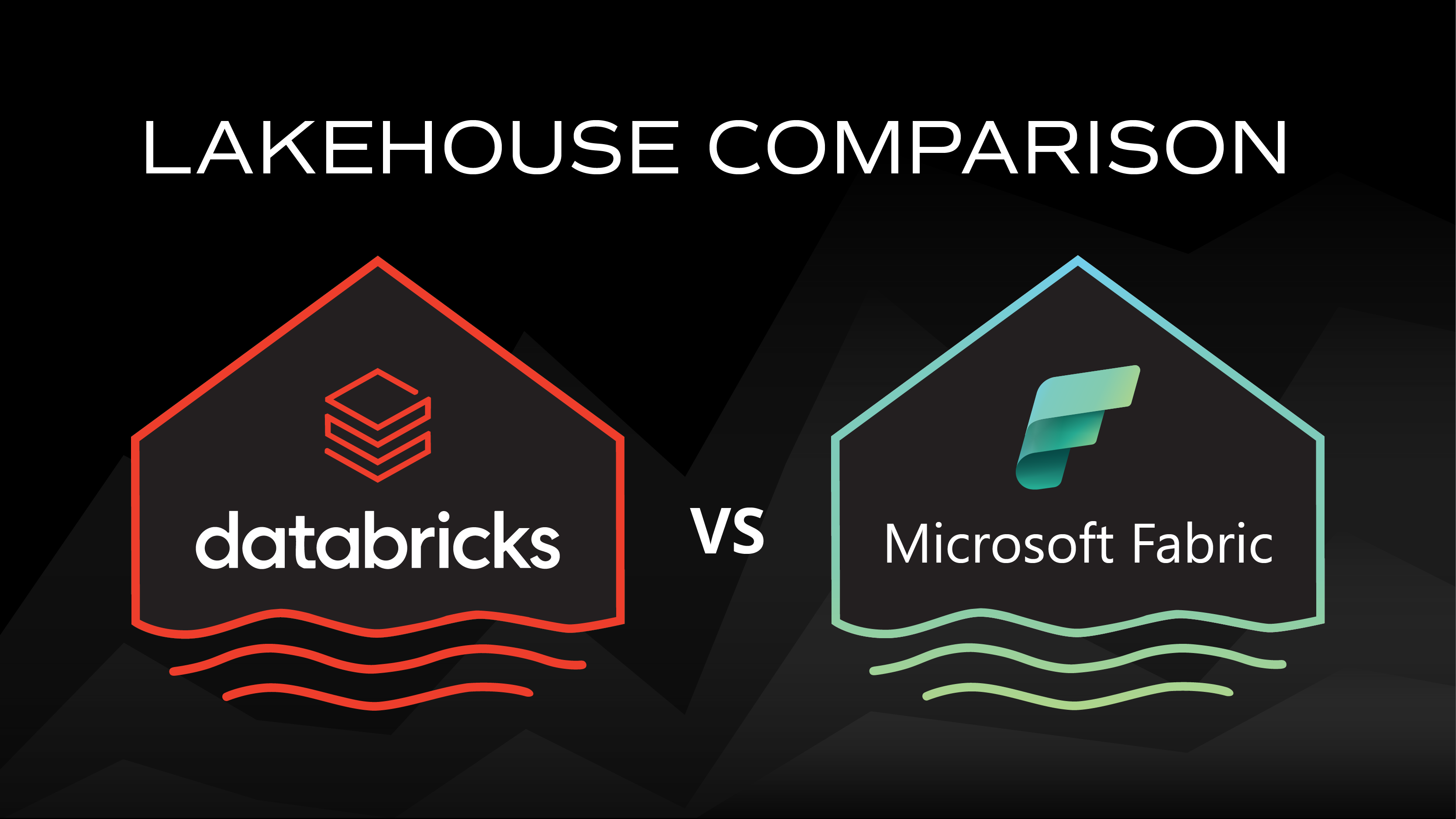
Databricks vs Microsoft Fabric: Choosing the Right Foundation for Your Enterprise Analytics
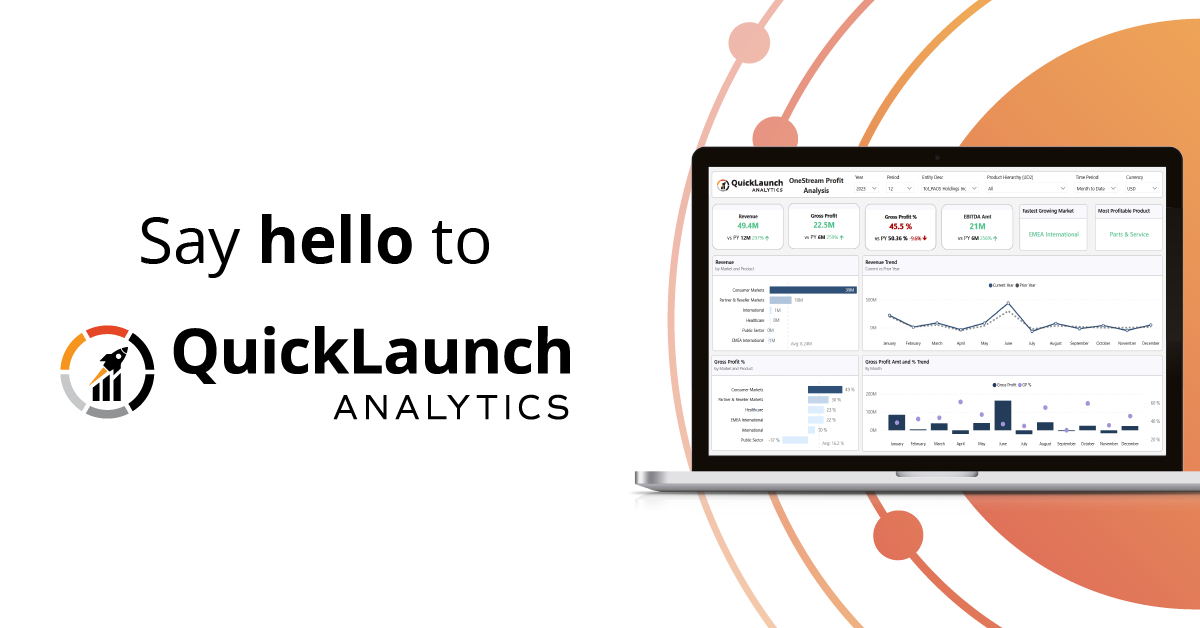
Unveiling QuickLaunch Analytics: Transforming Data into Knowledge
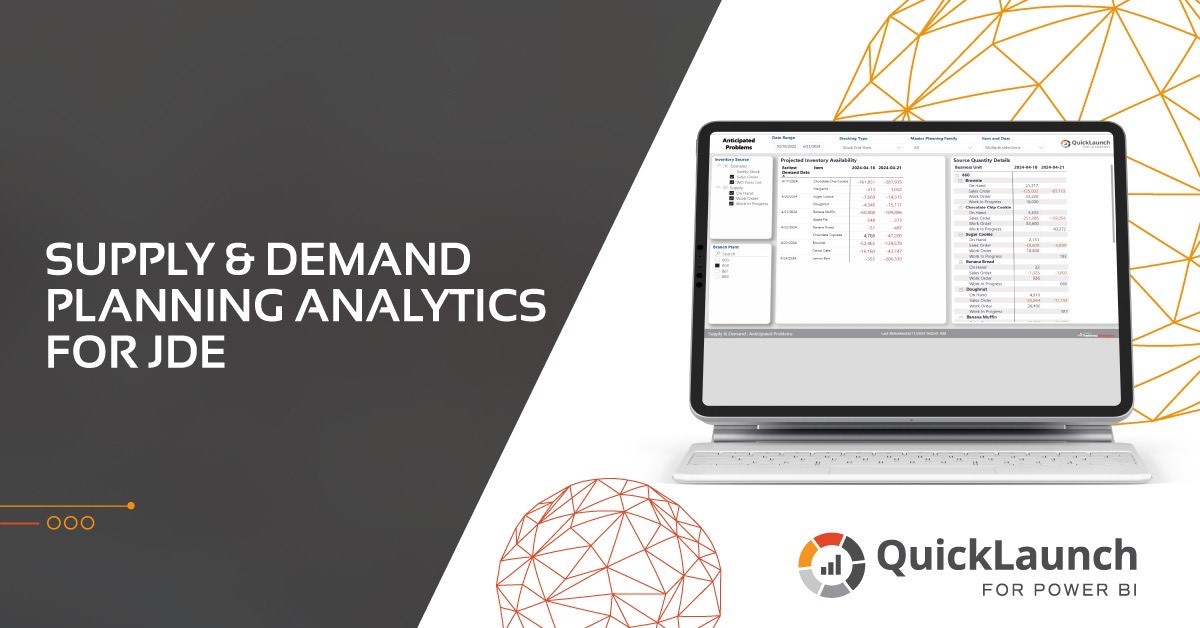
Maximize Efficiency with Supply and Demand Planning Analytics for JD Edwards

QuickLaunch for Vista Release Notes: Payroll Detail, Equipment Maintenance, Warranty Details and Much More!

Power BI Updates for Enterprise Analytics: Q2 2023 – Part 1

QuickLaunch Analytics Invites JD Edwards Users to Take a QuickLaunch Test Drive
- of 13
- Next >

